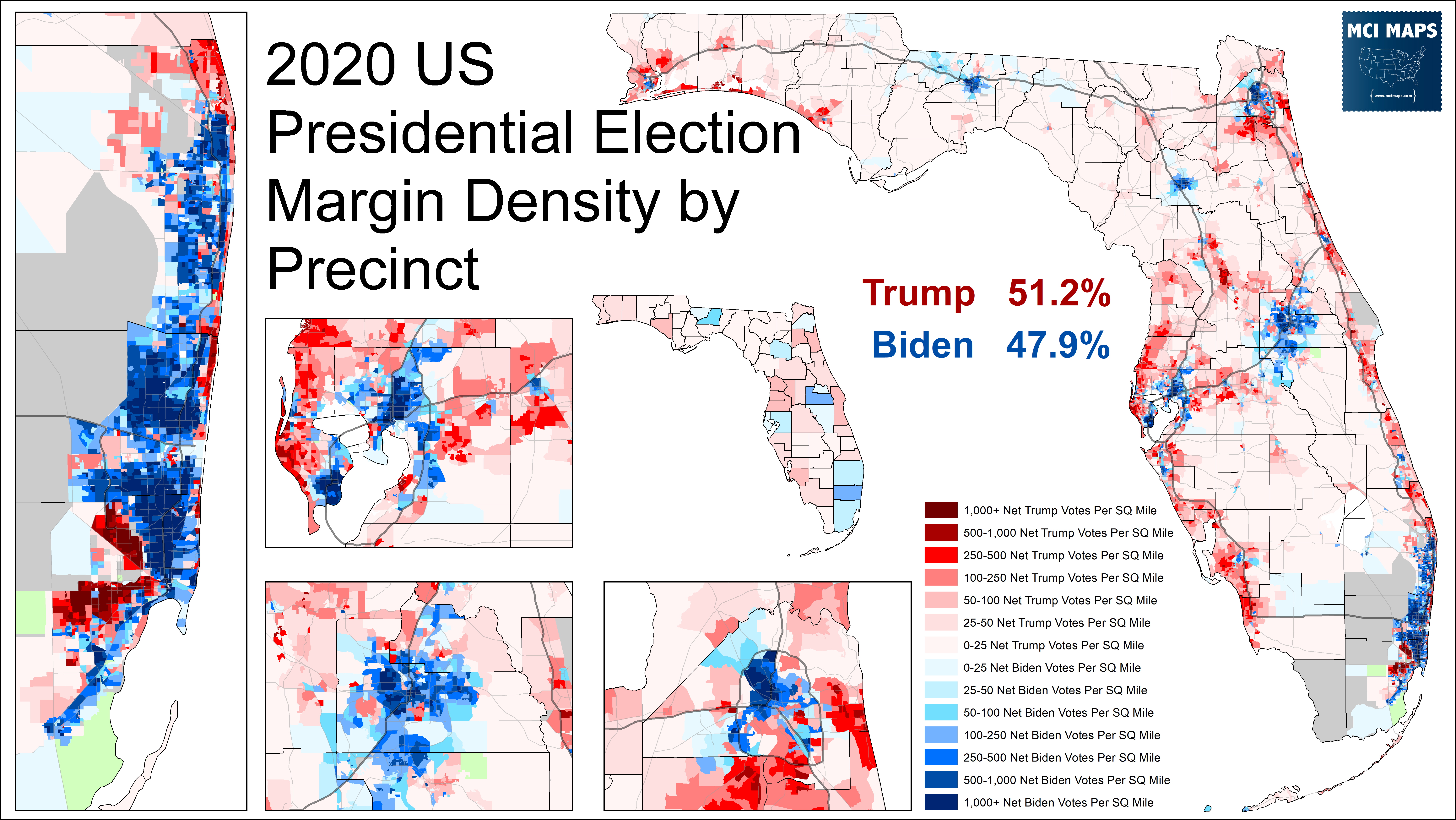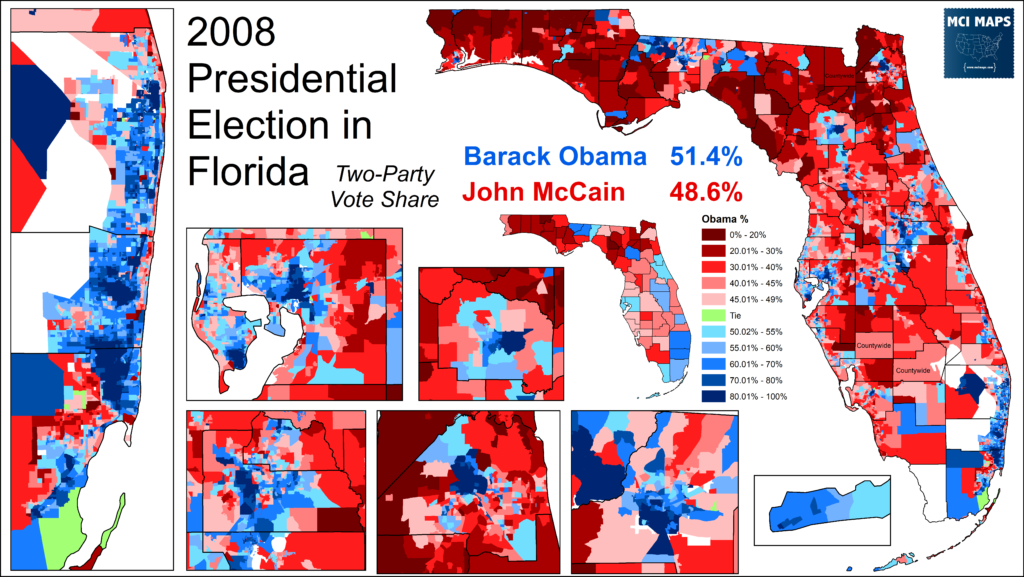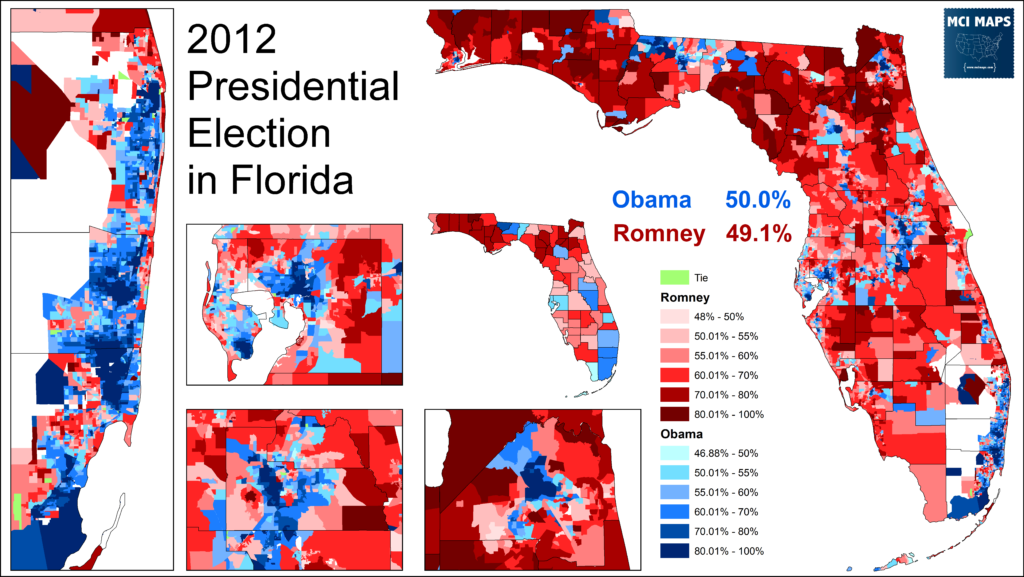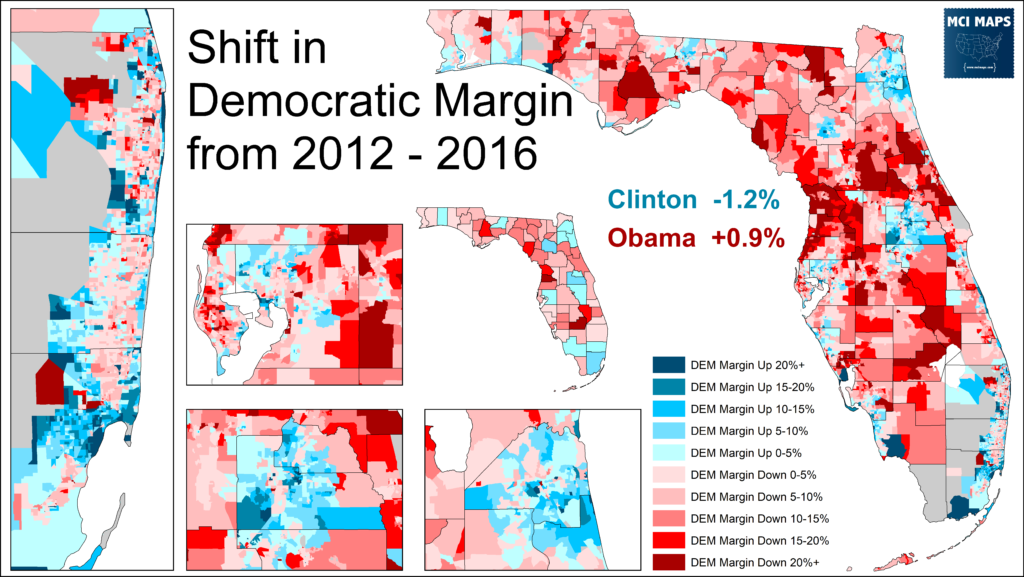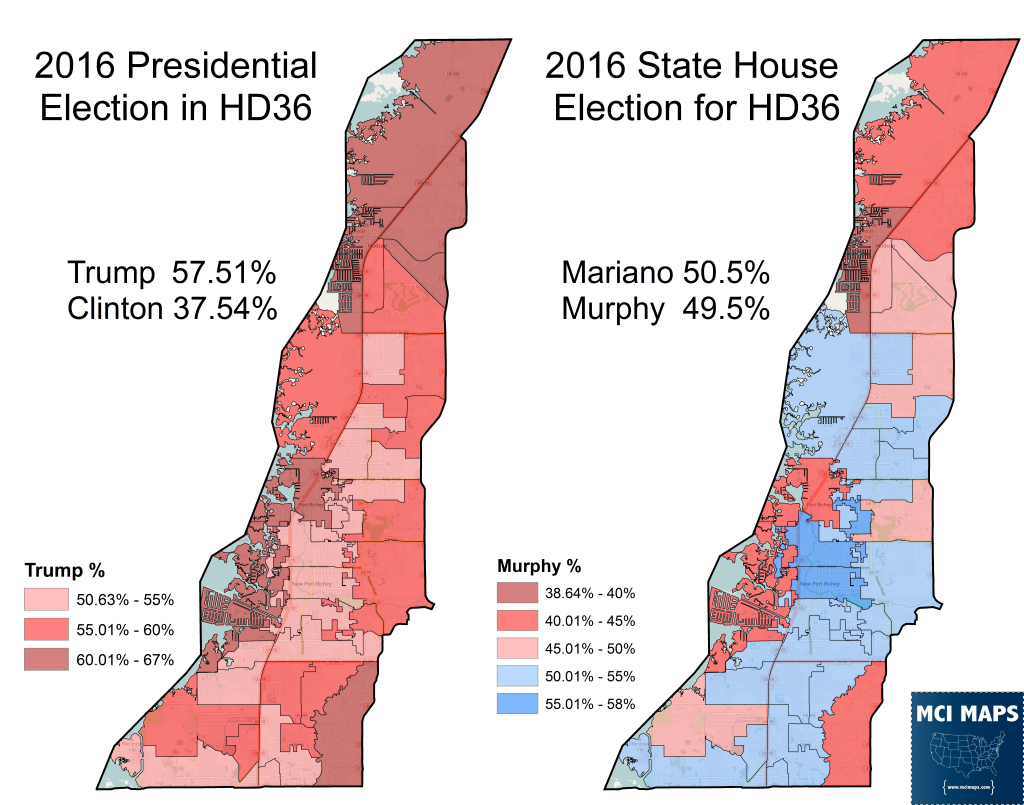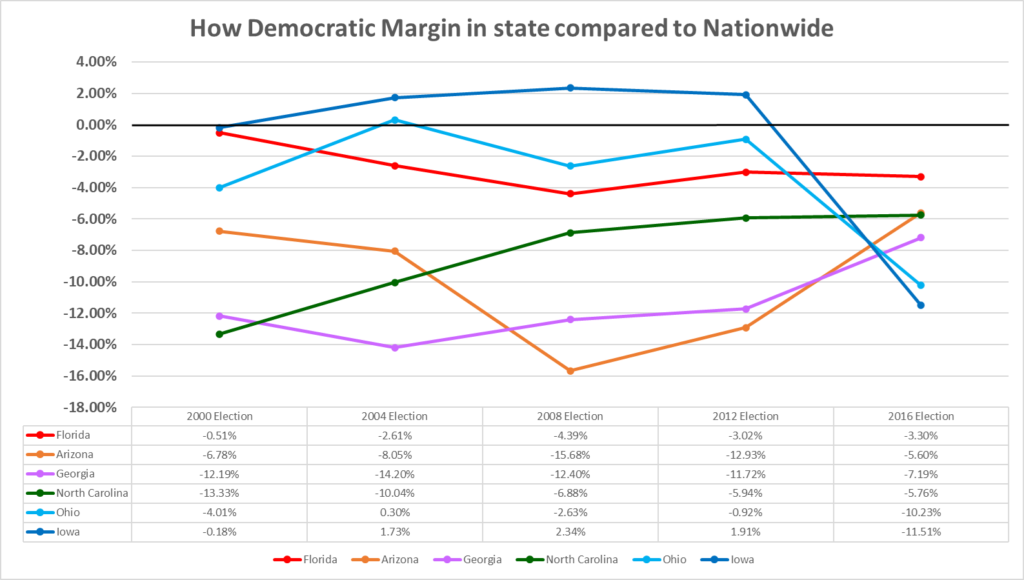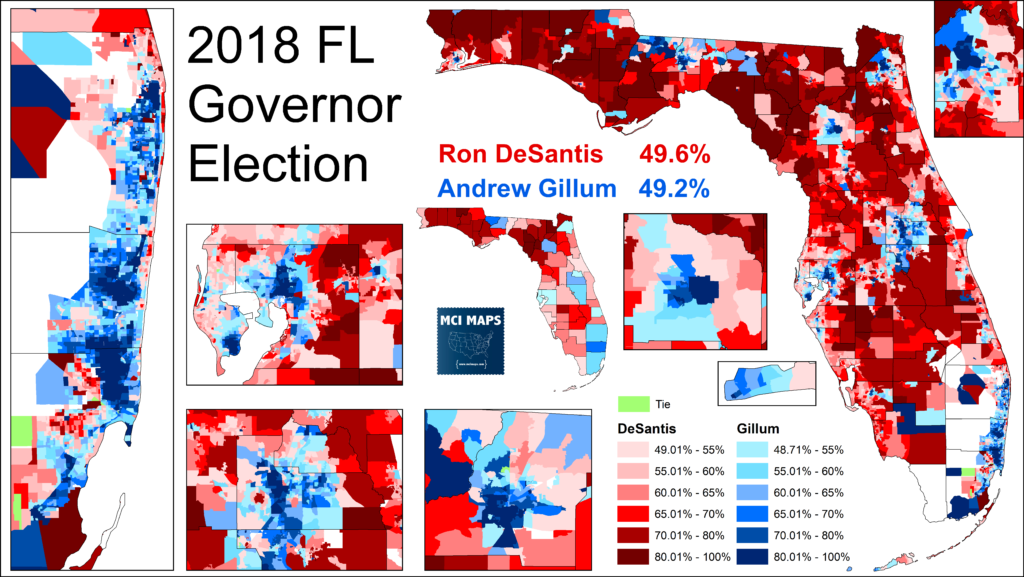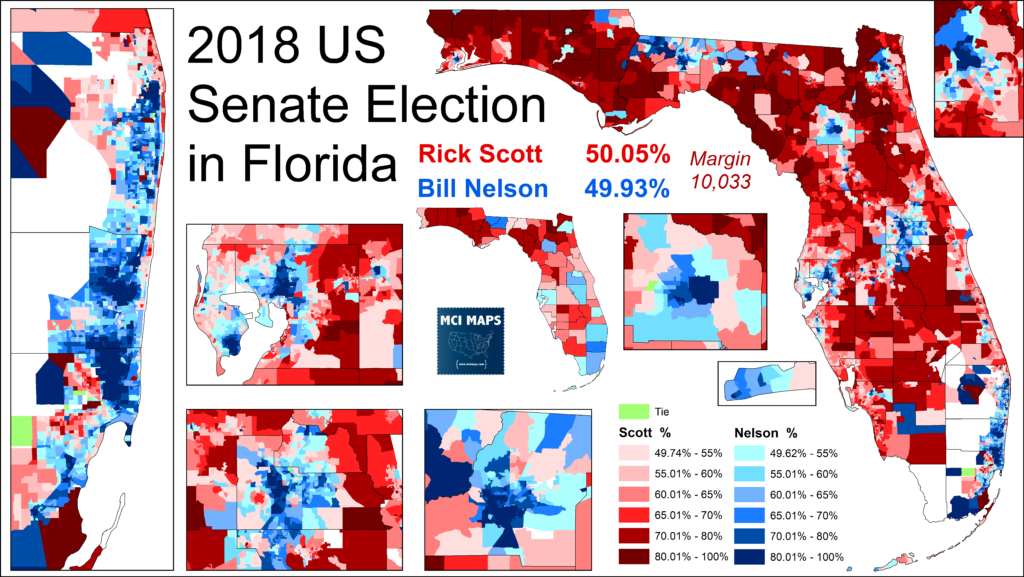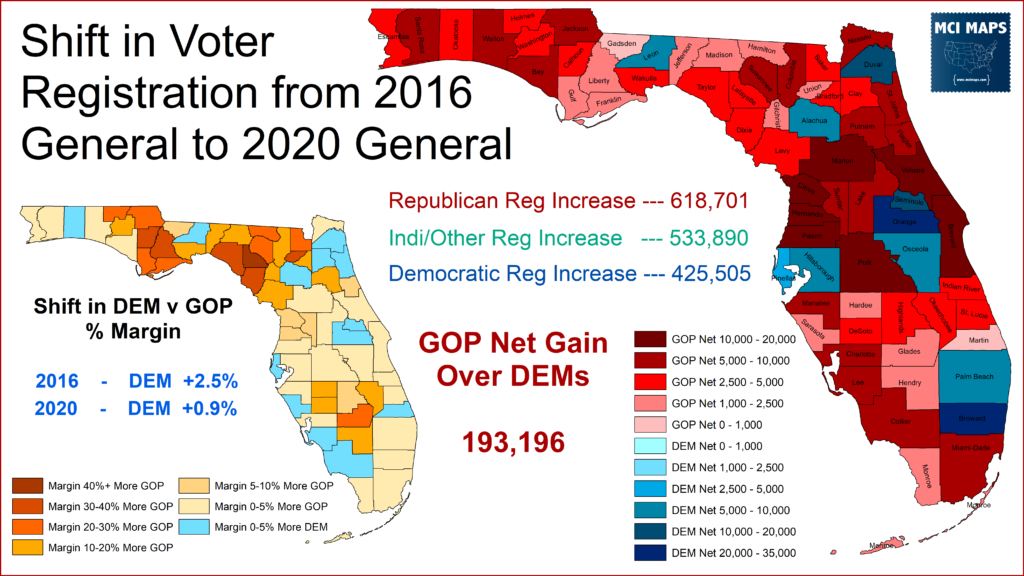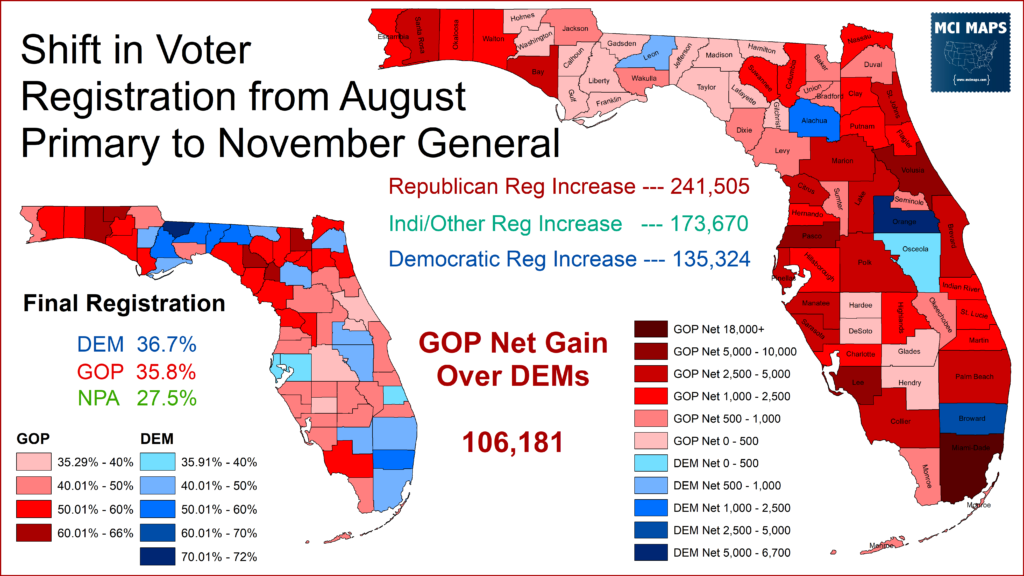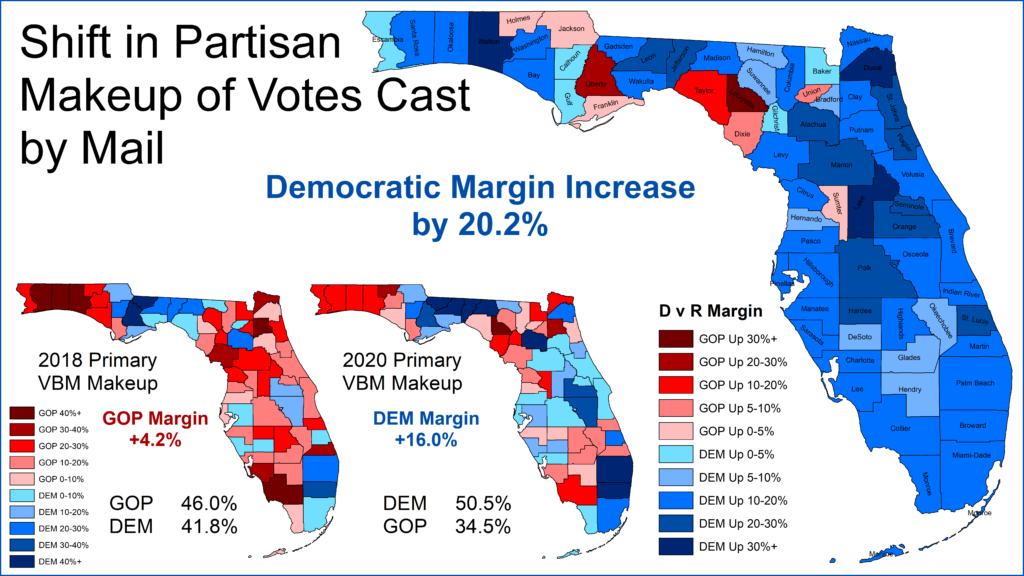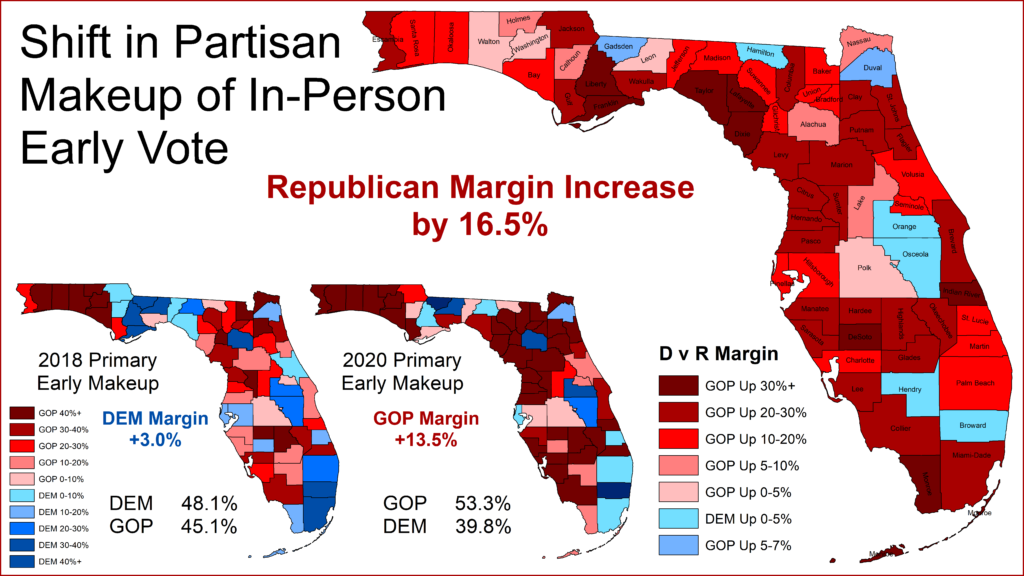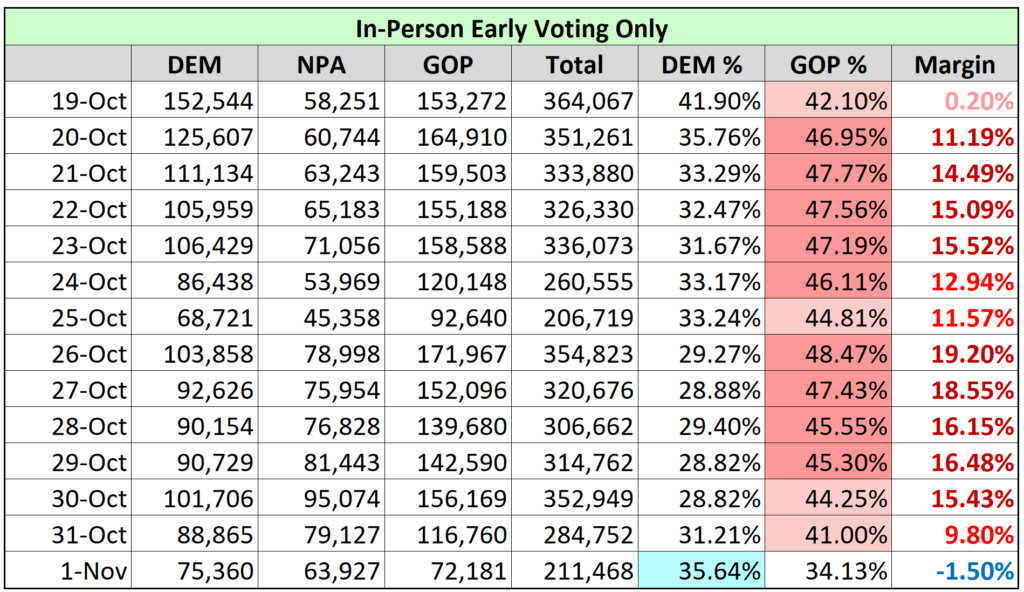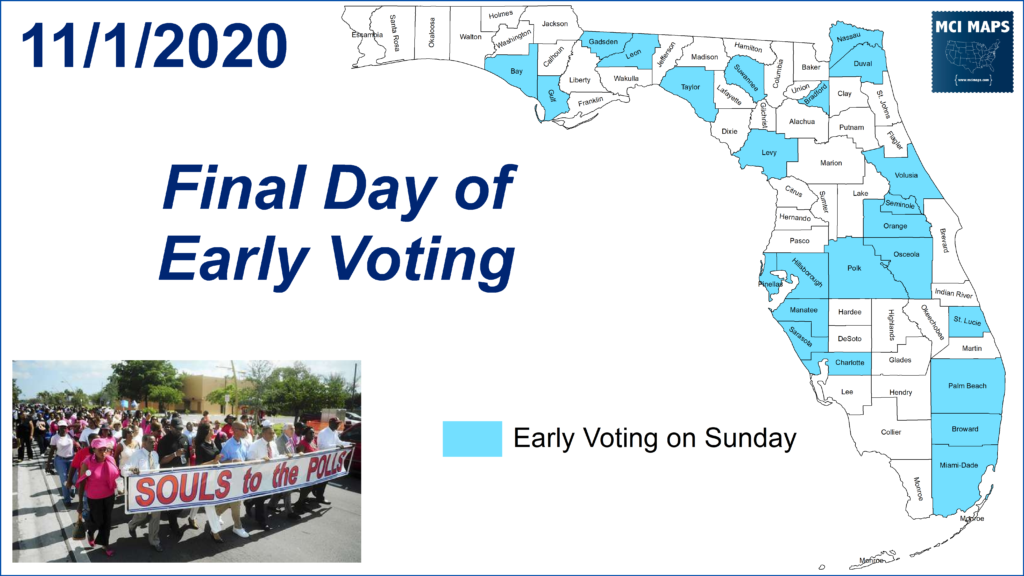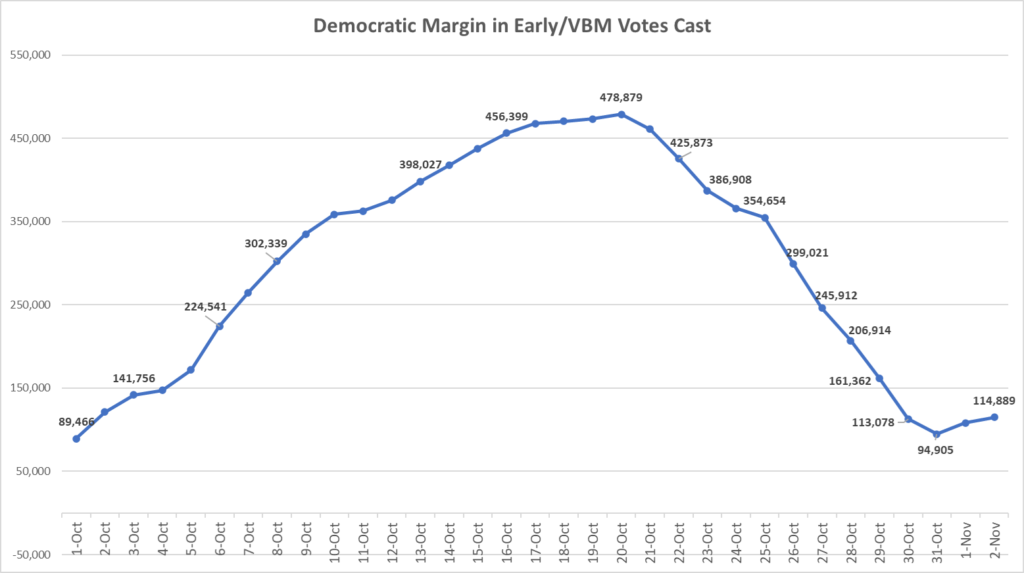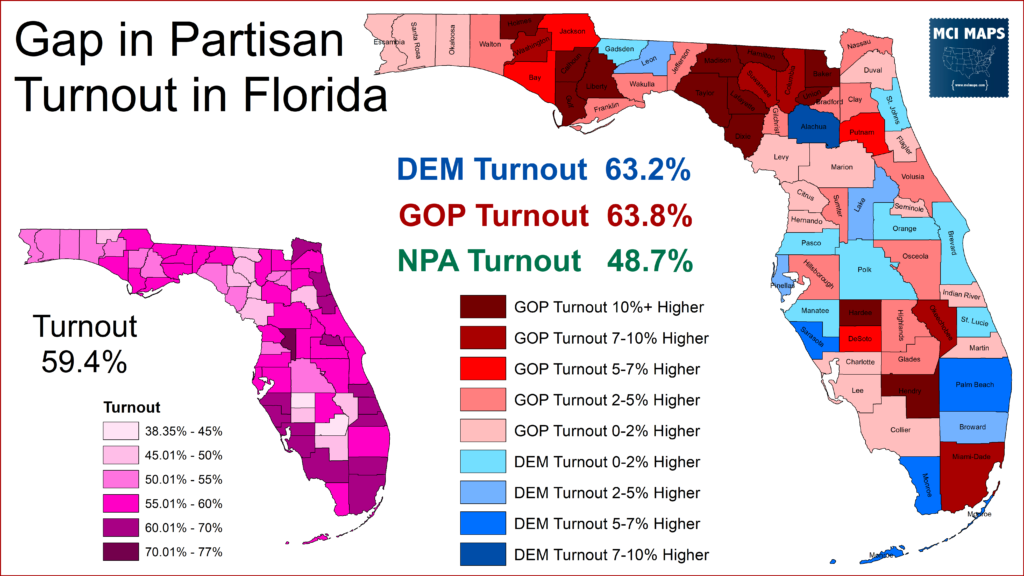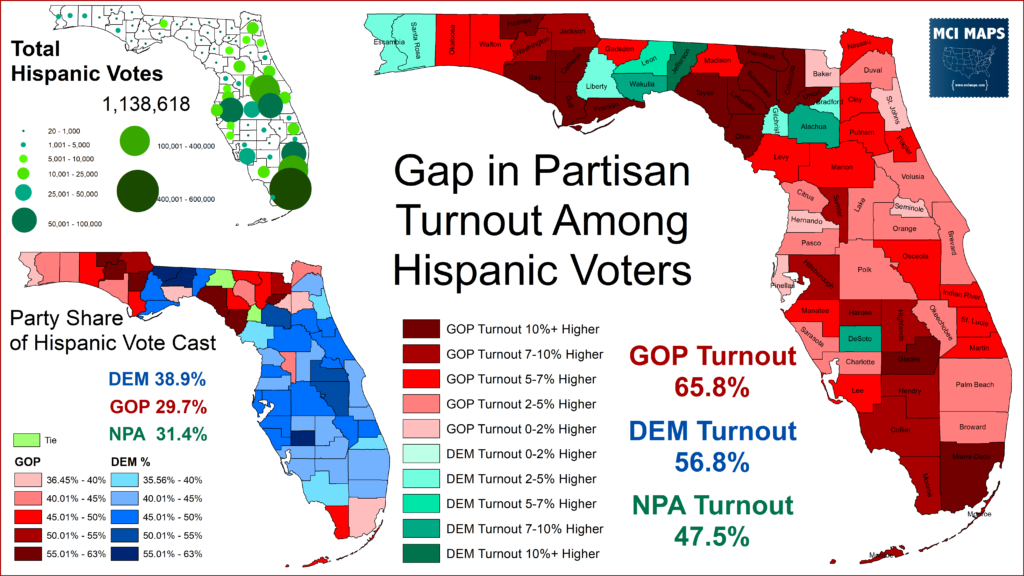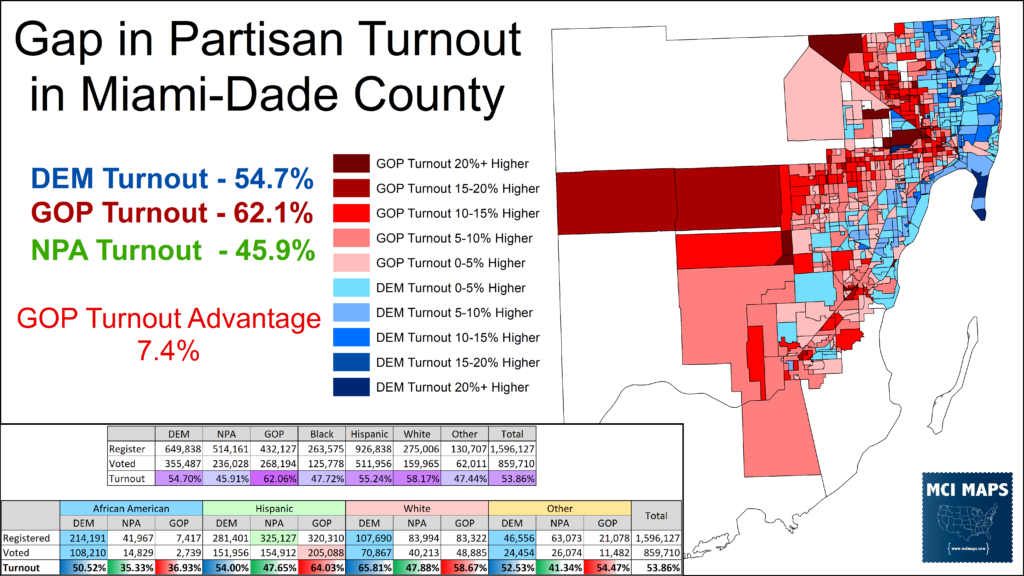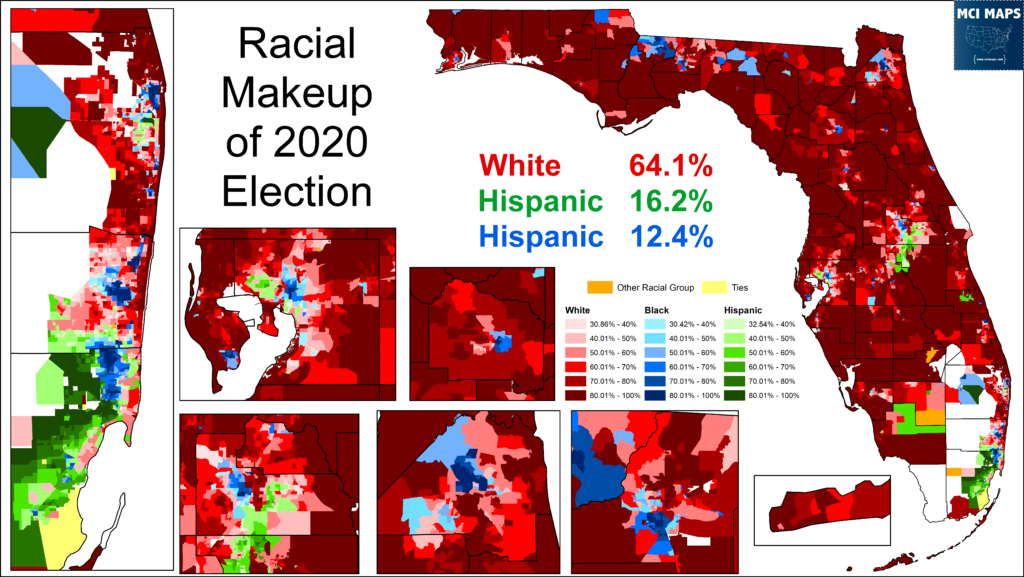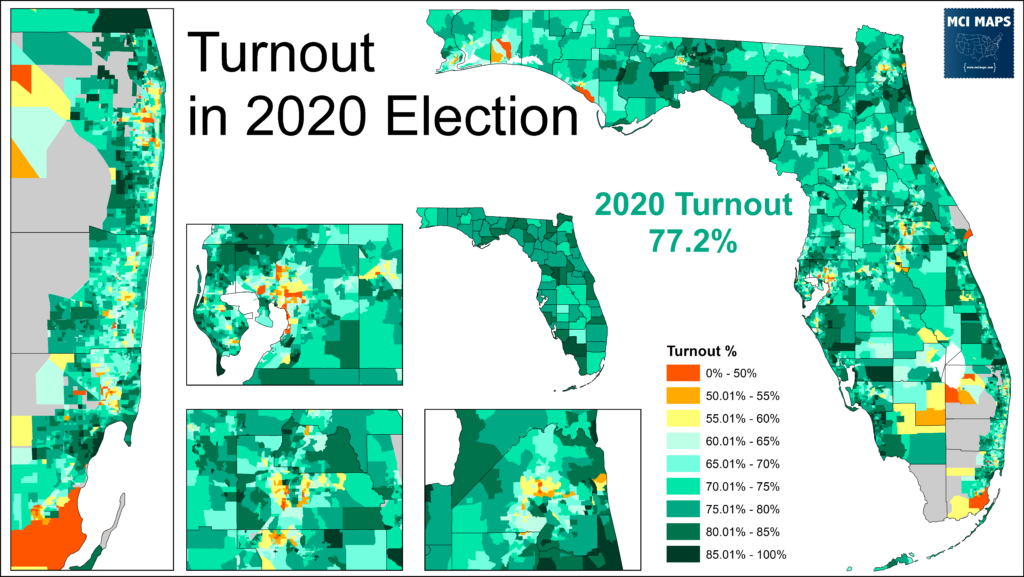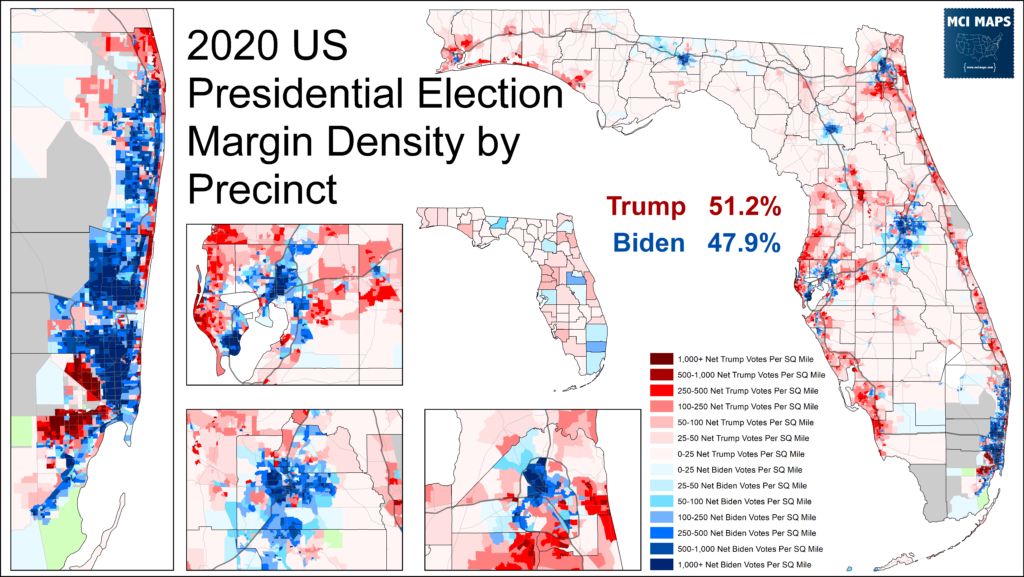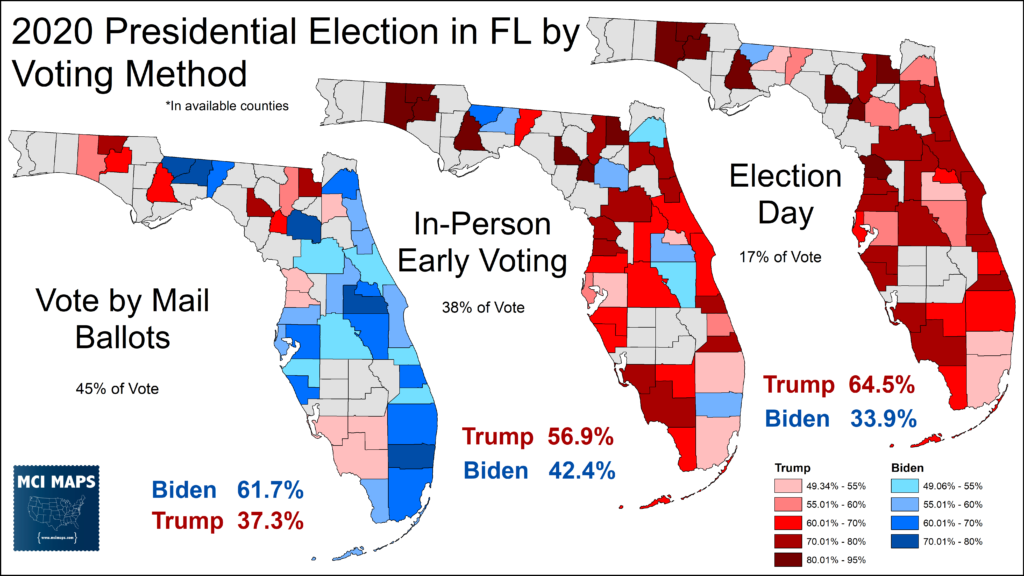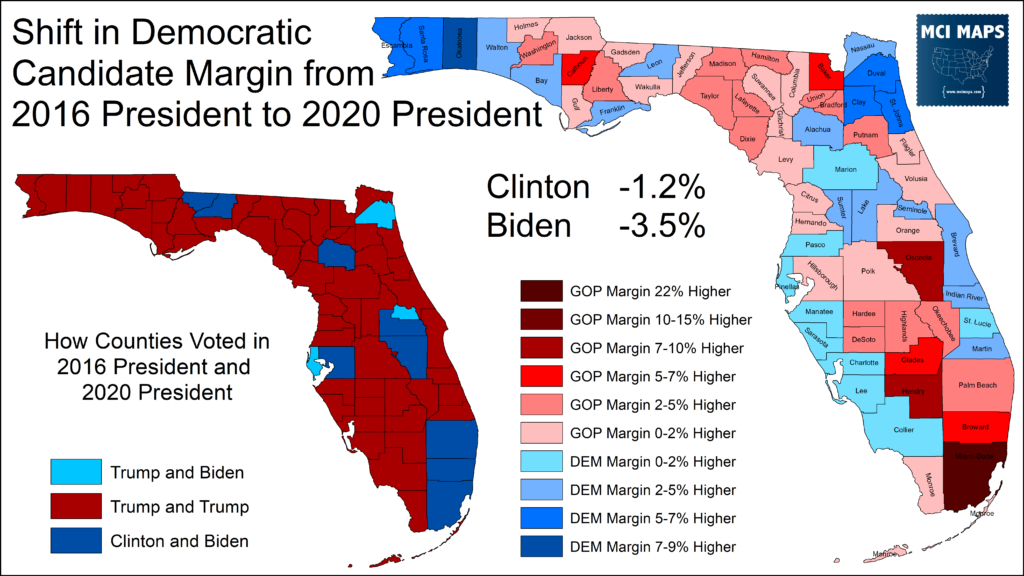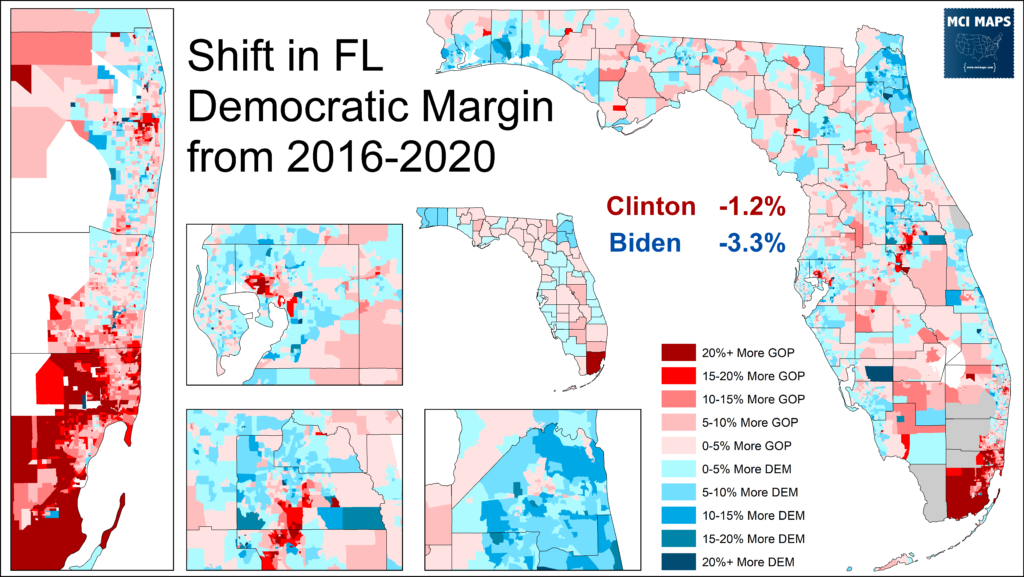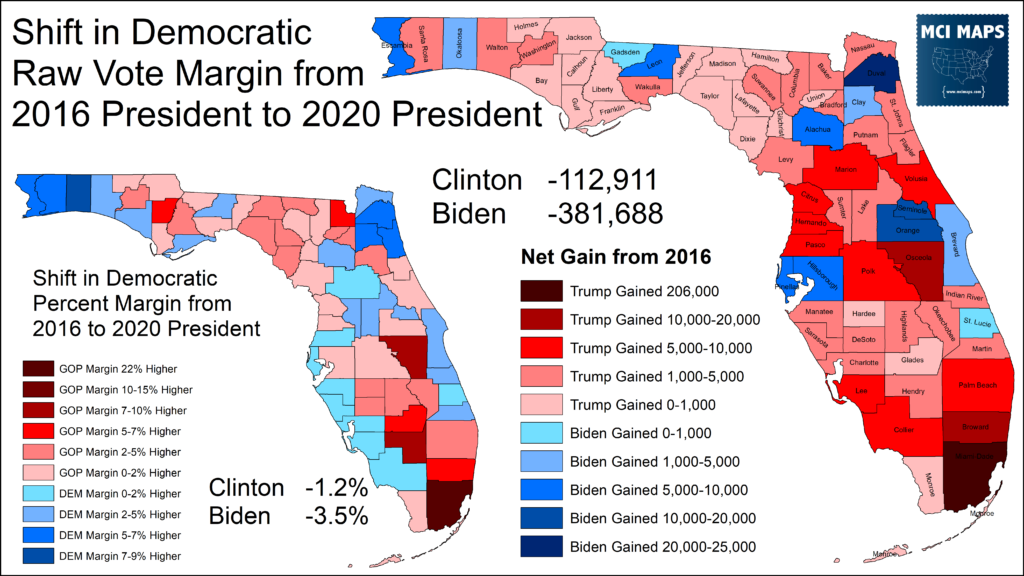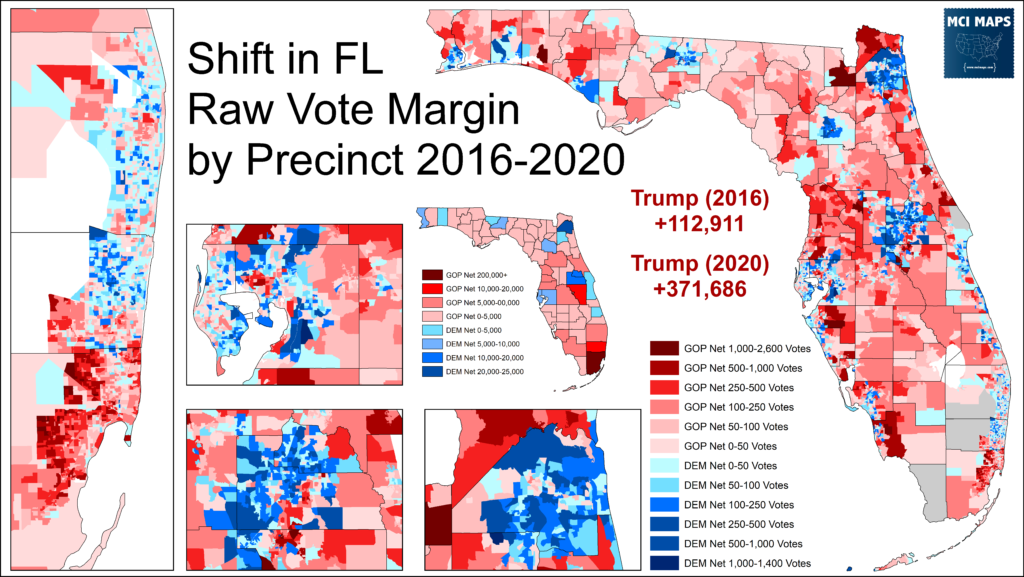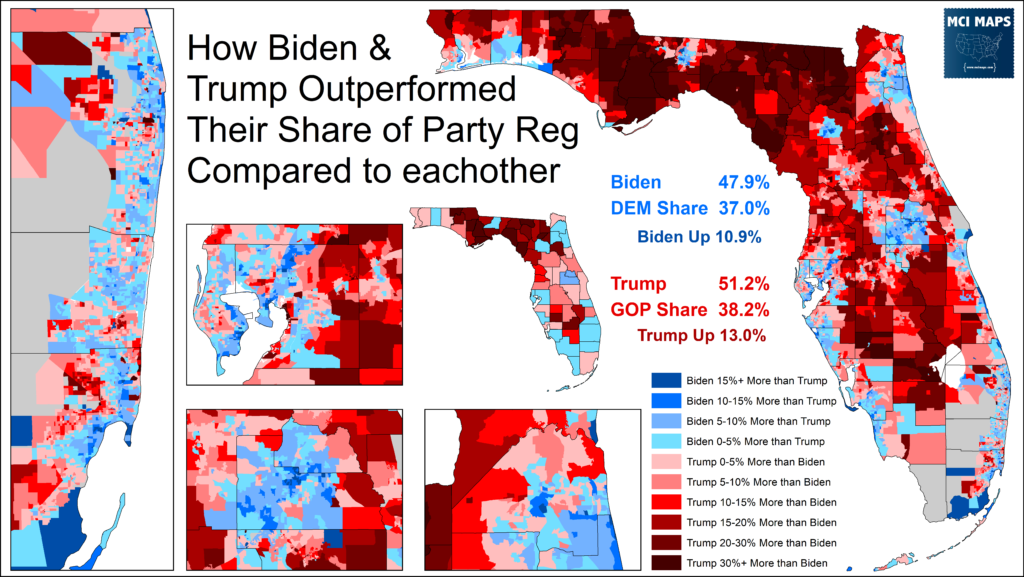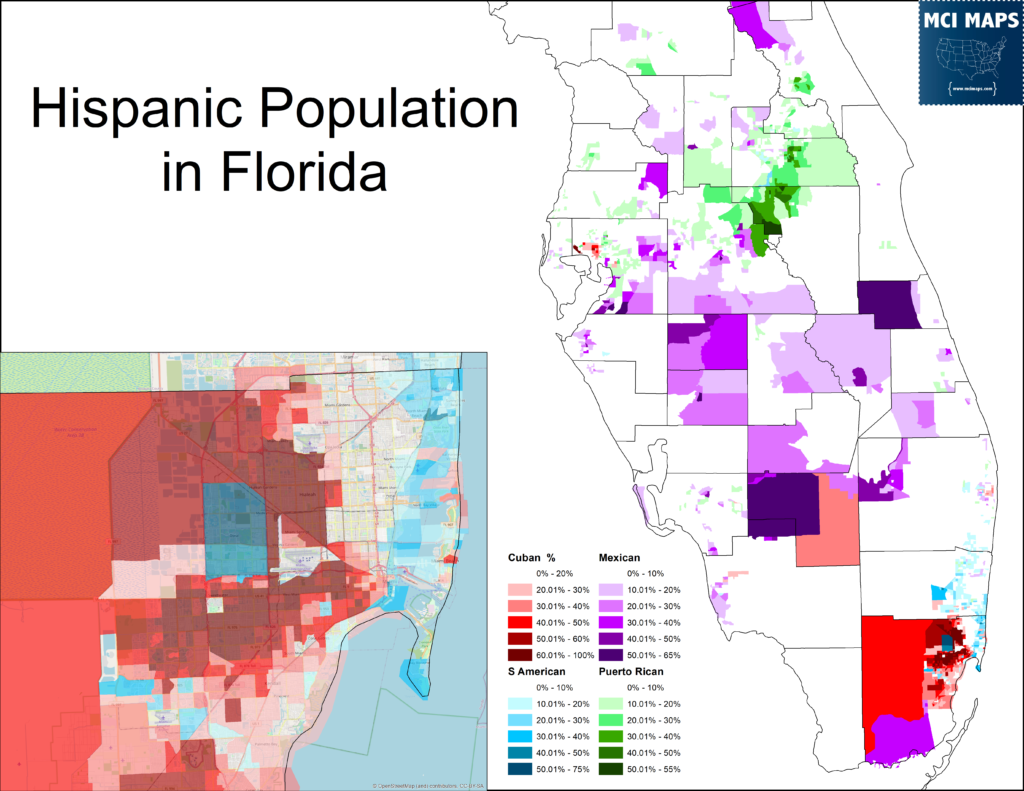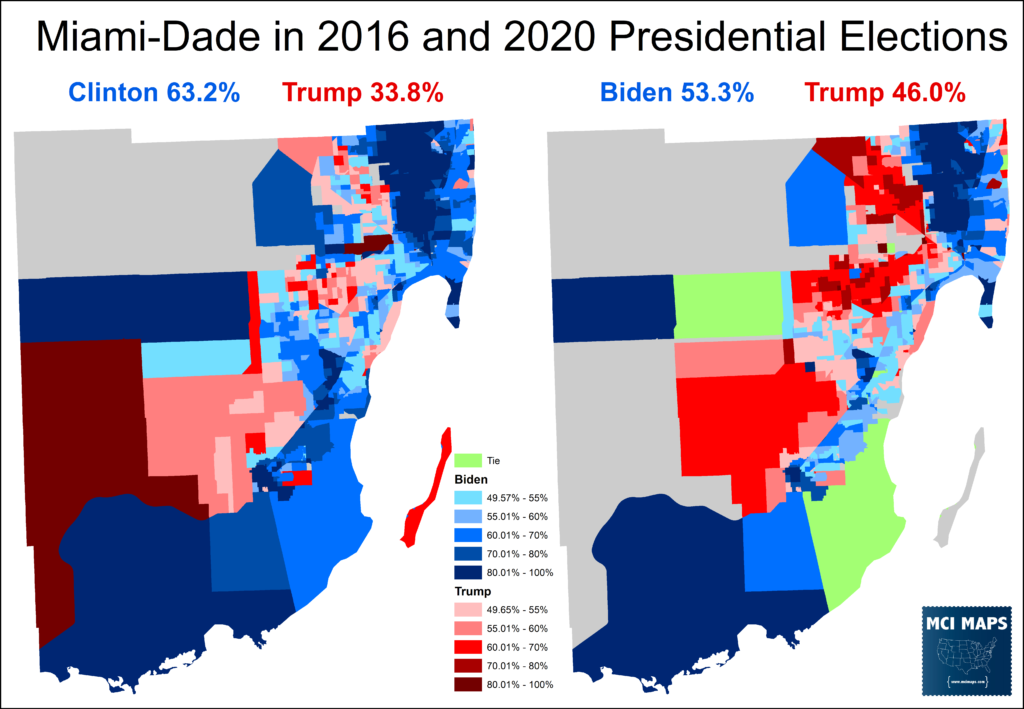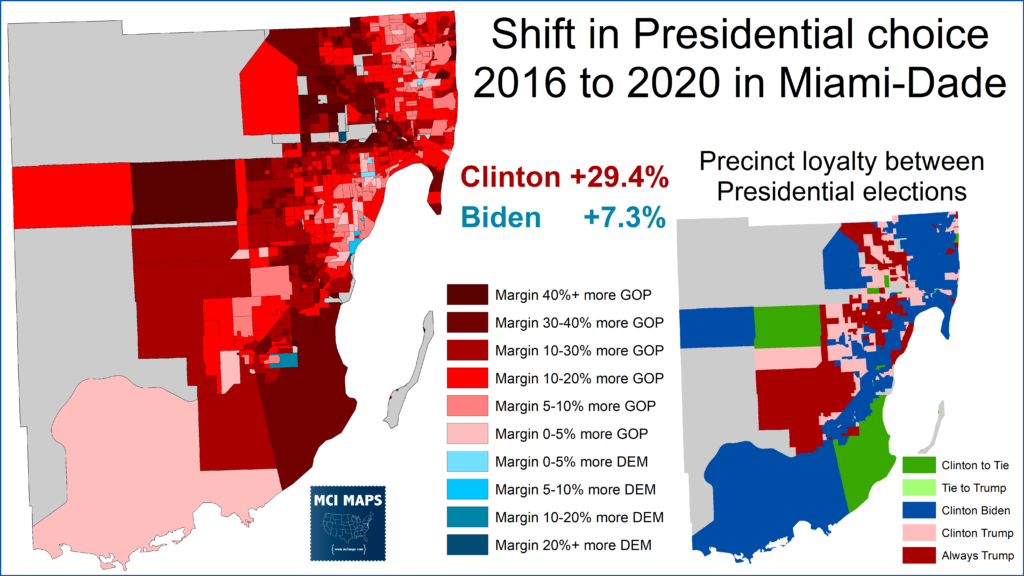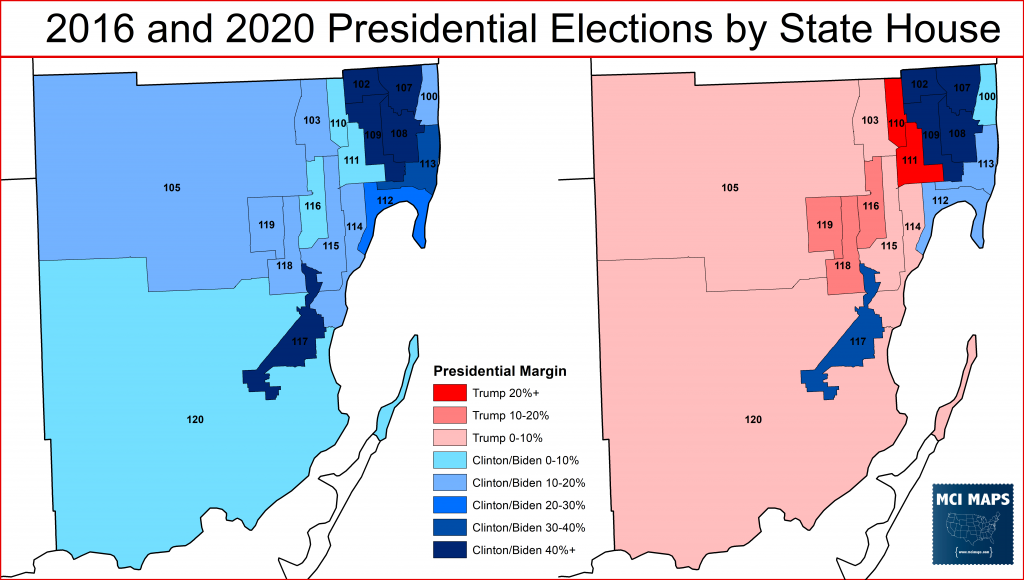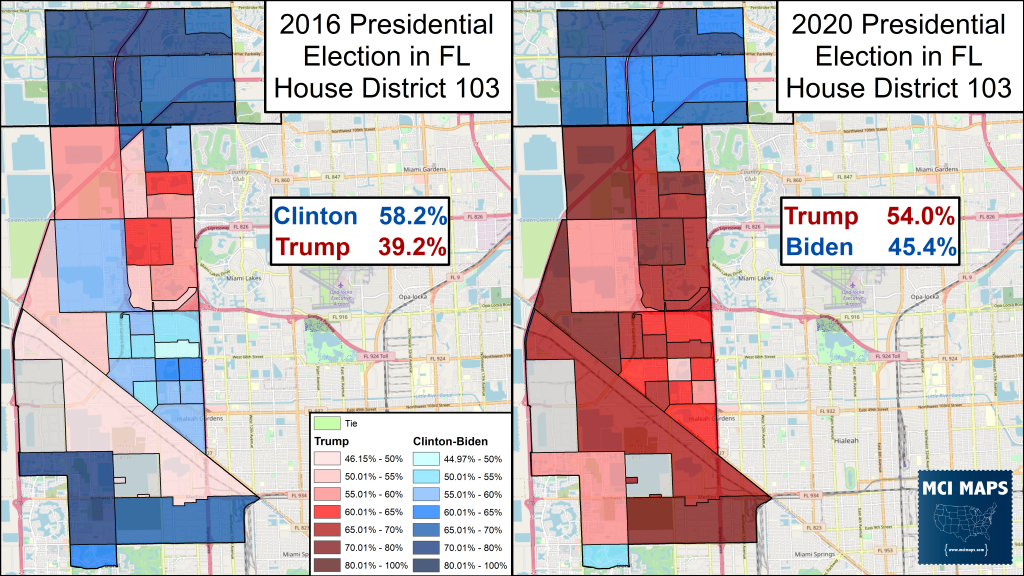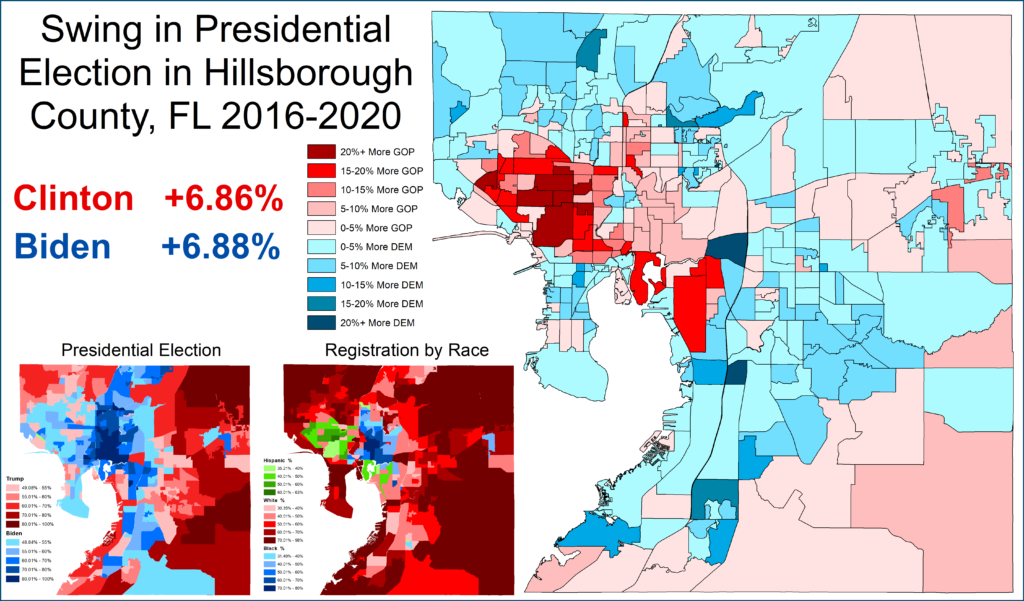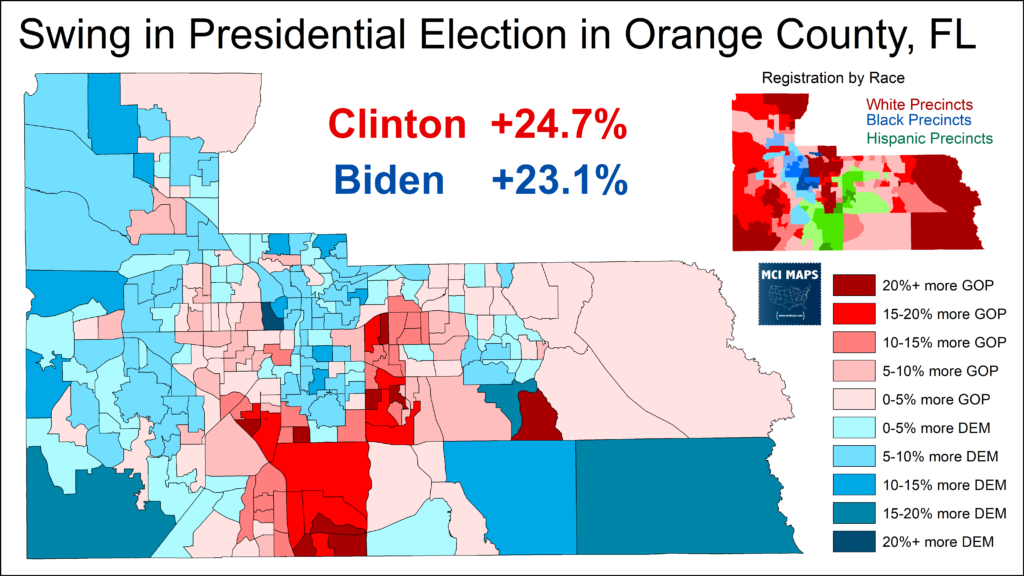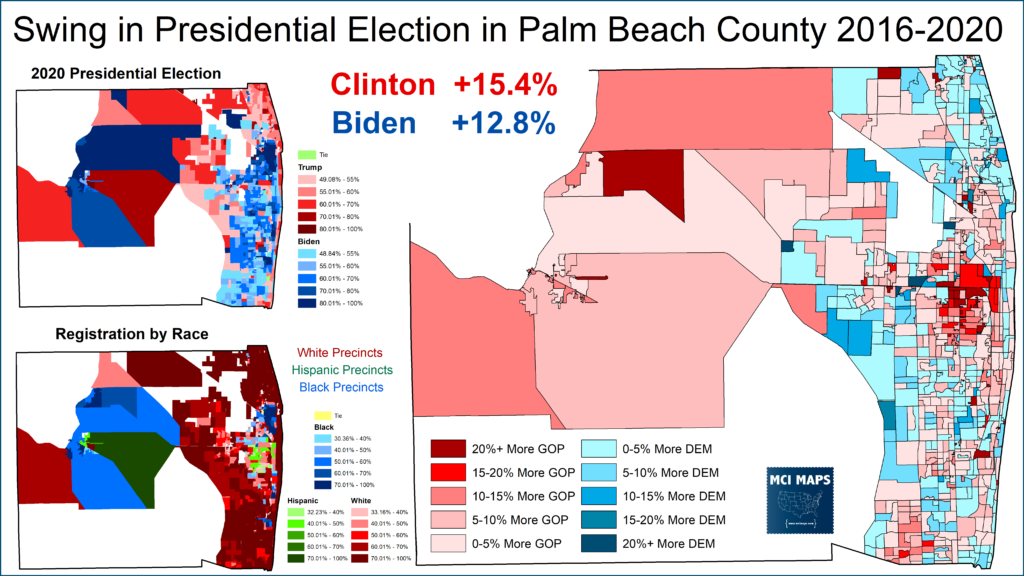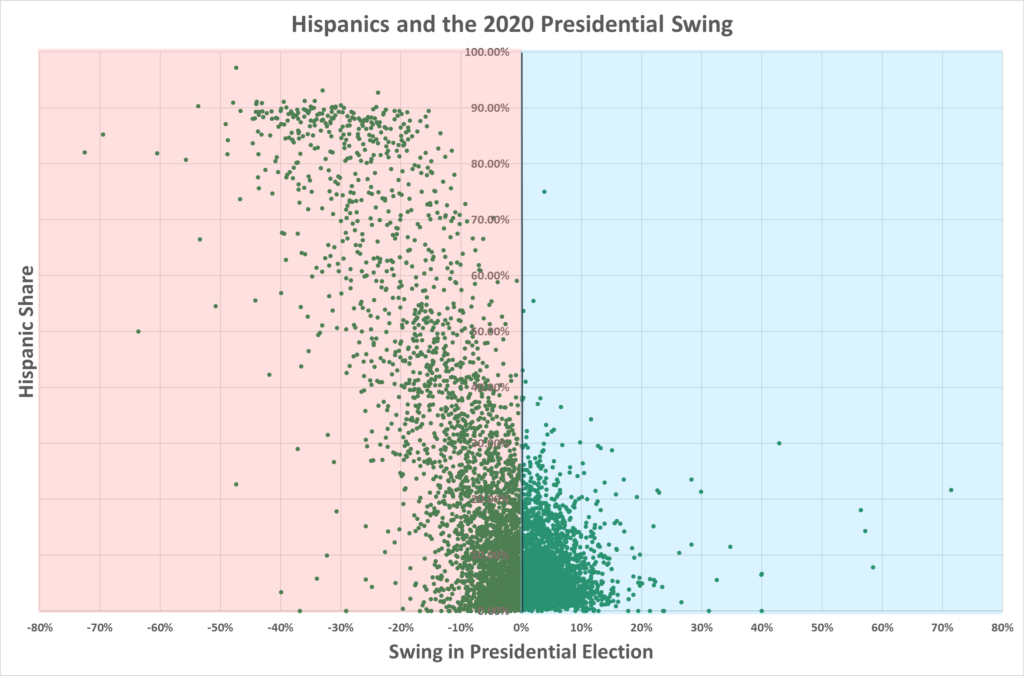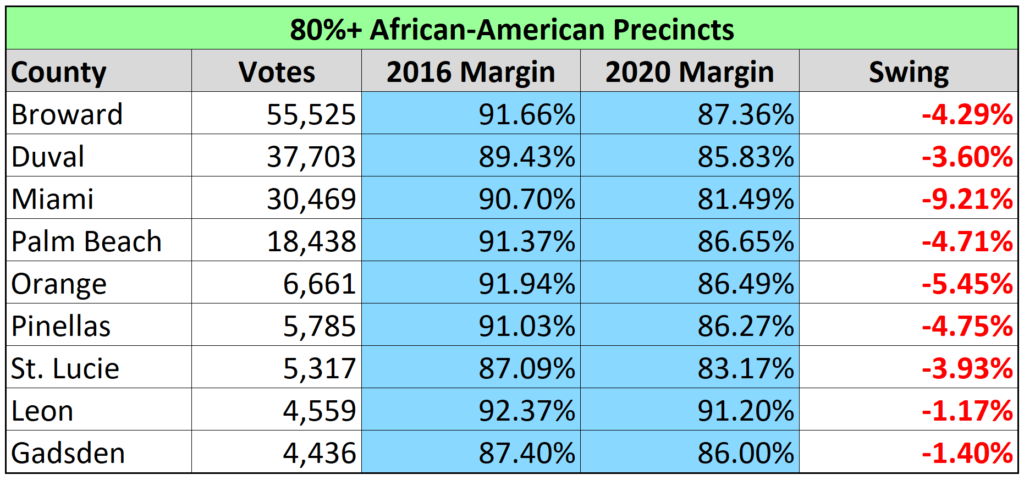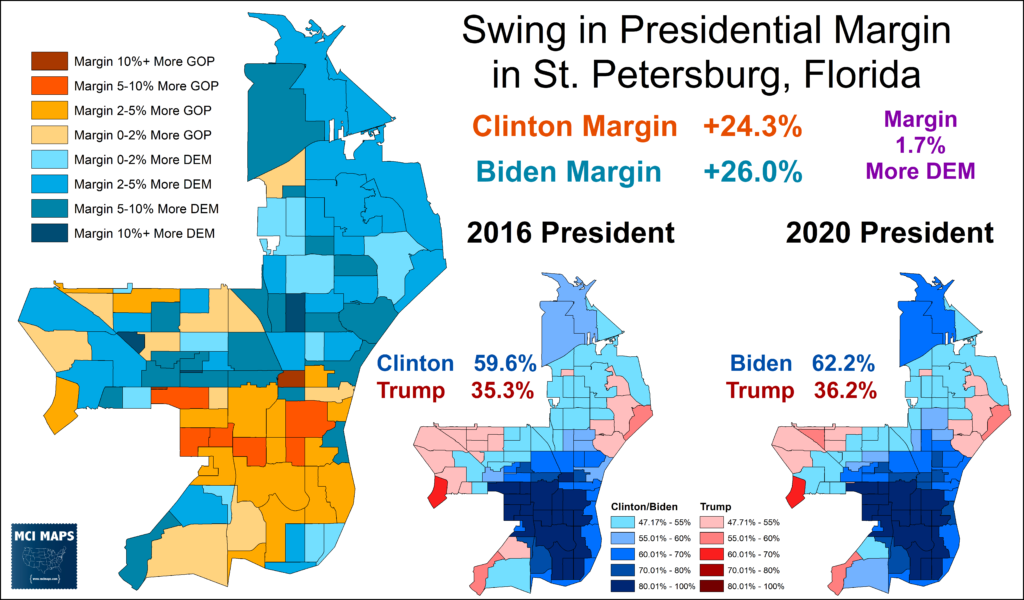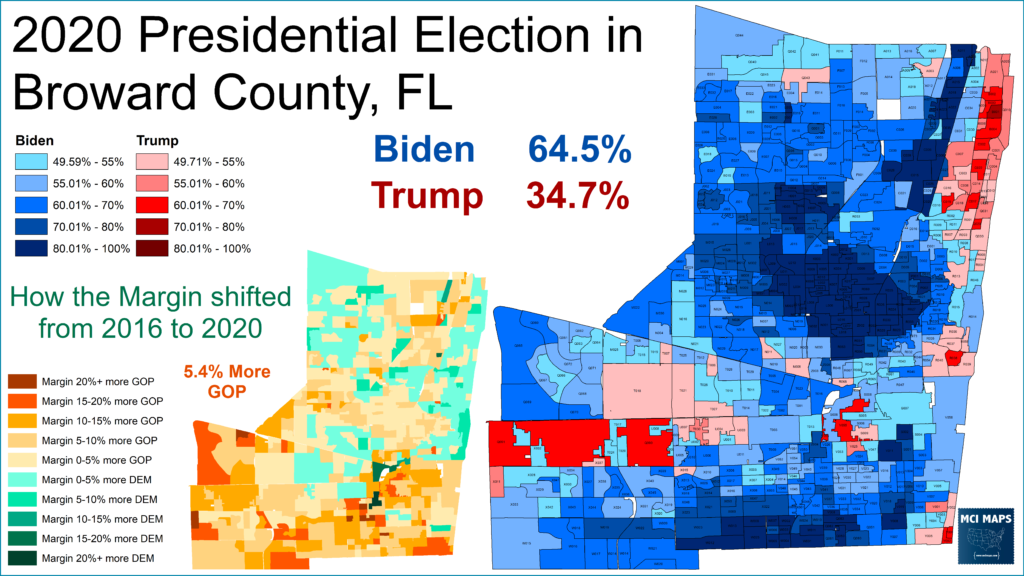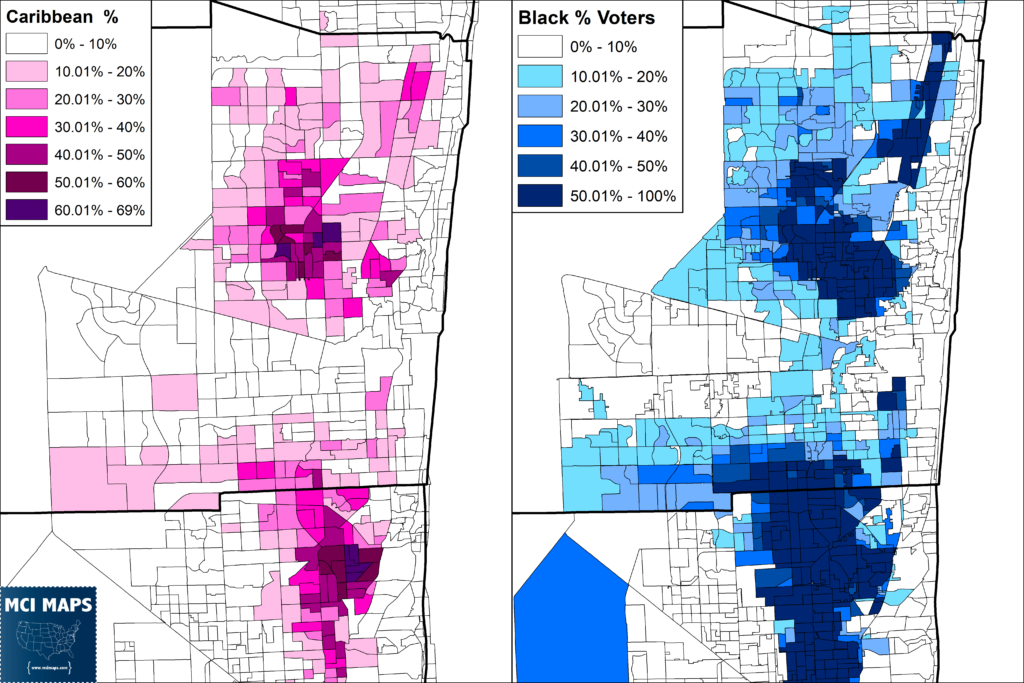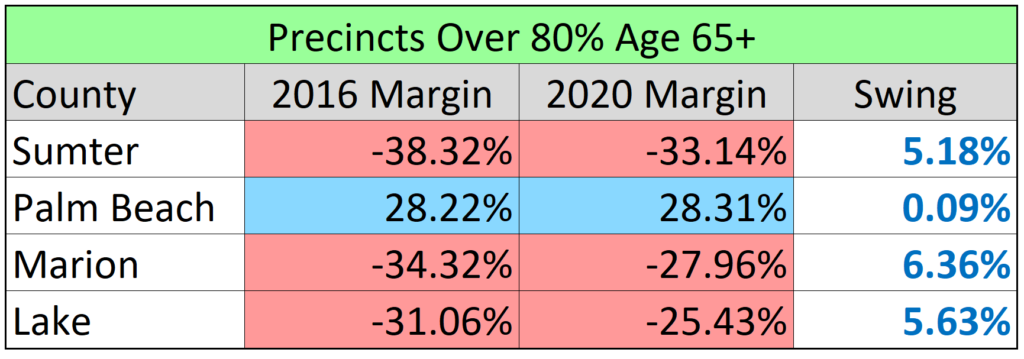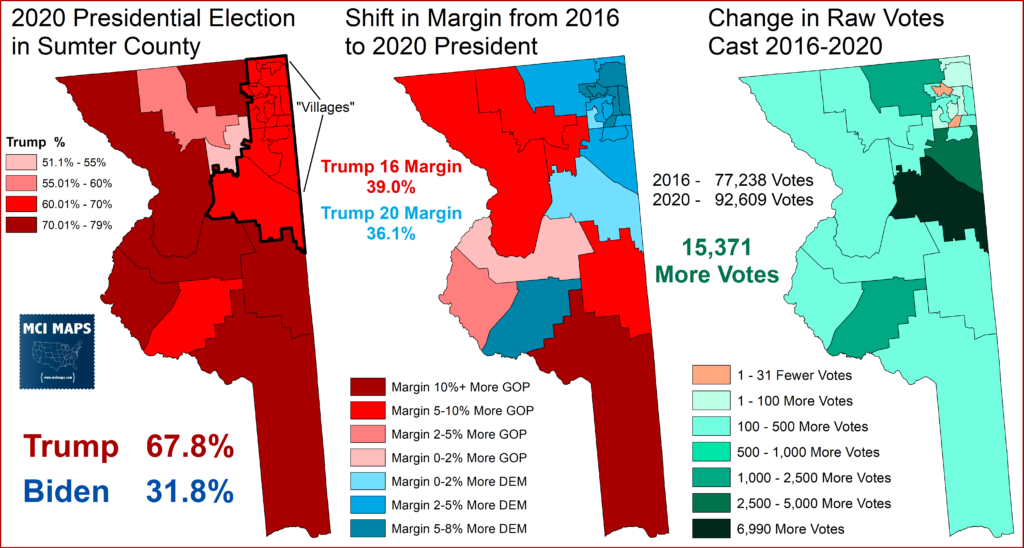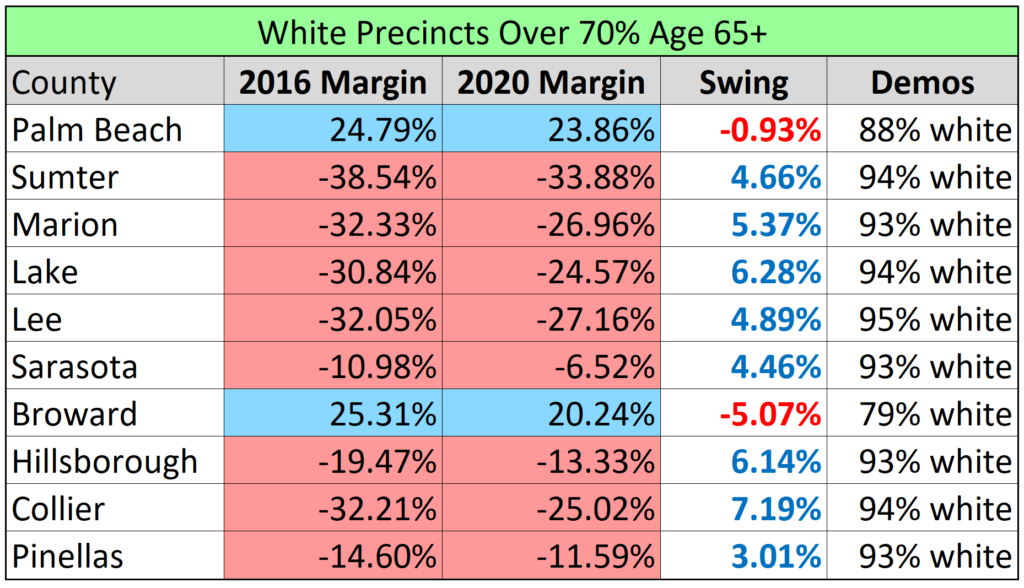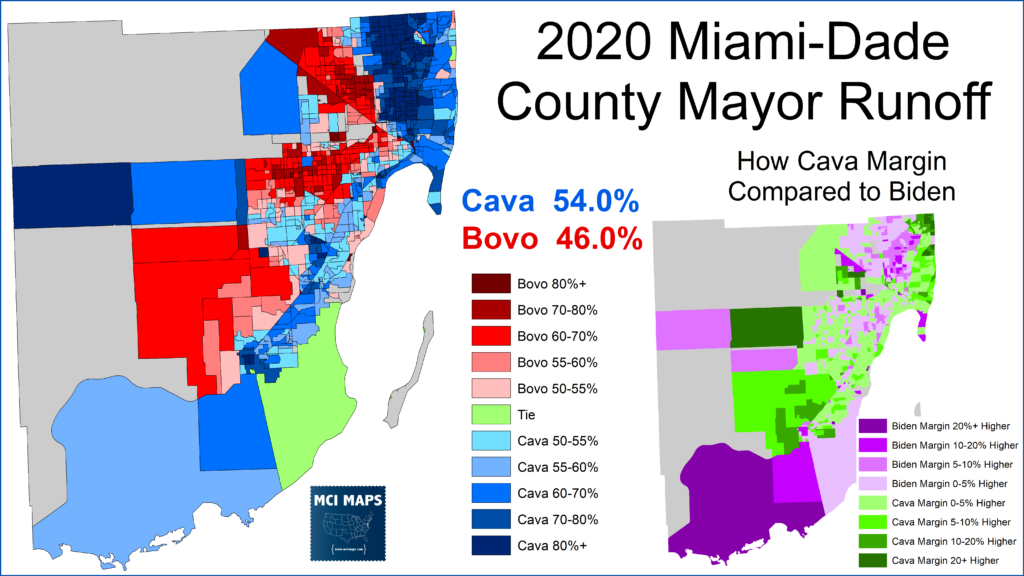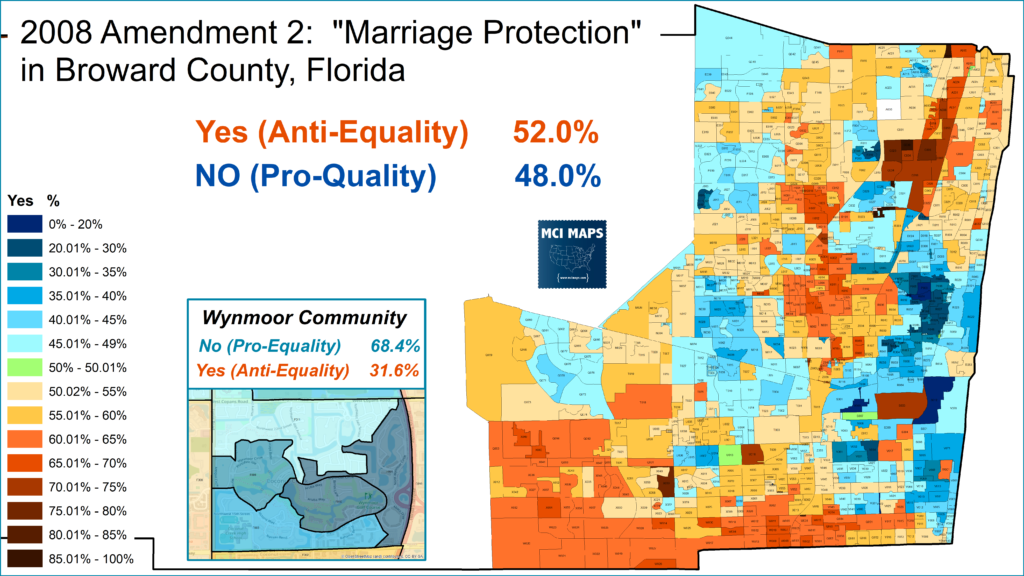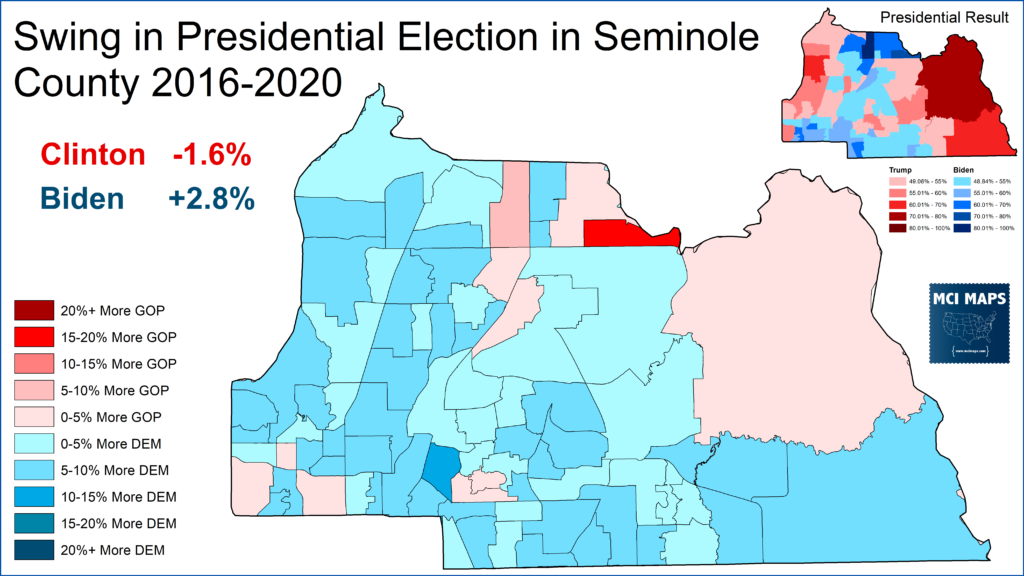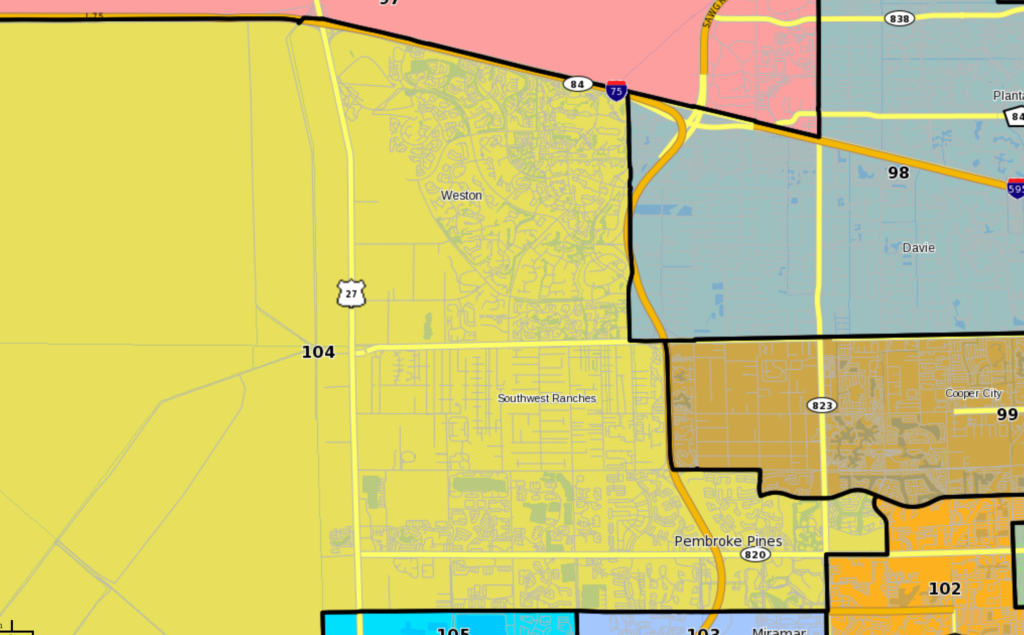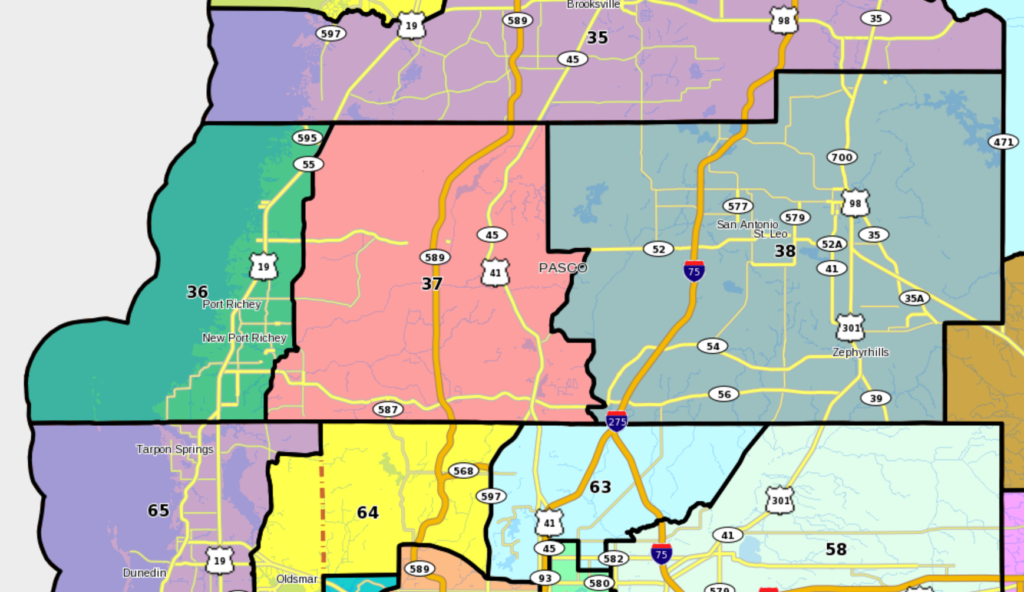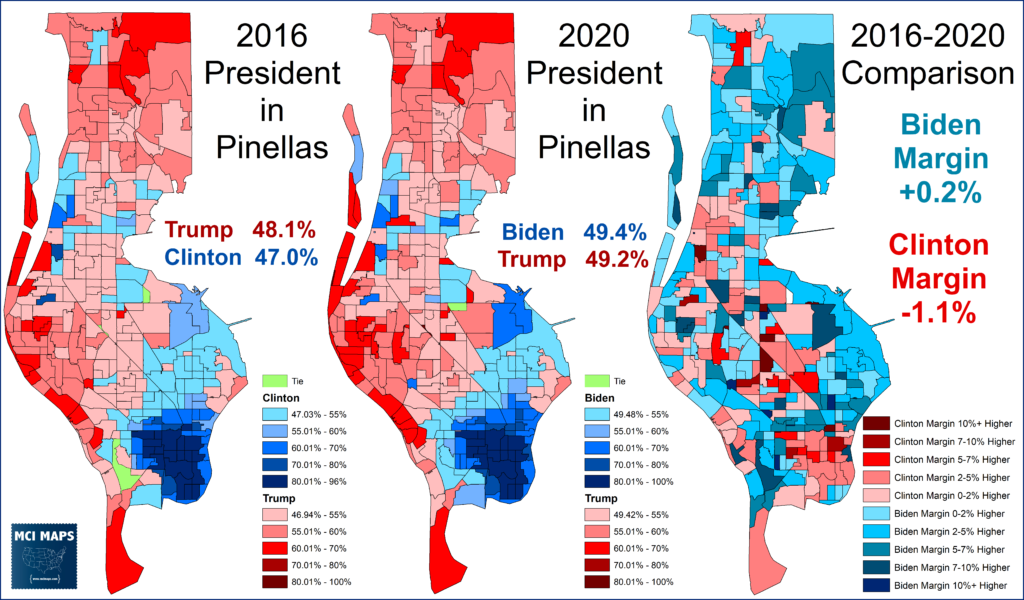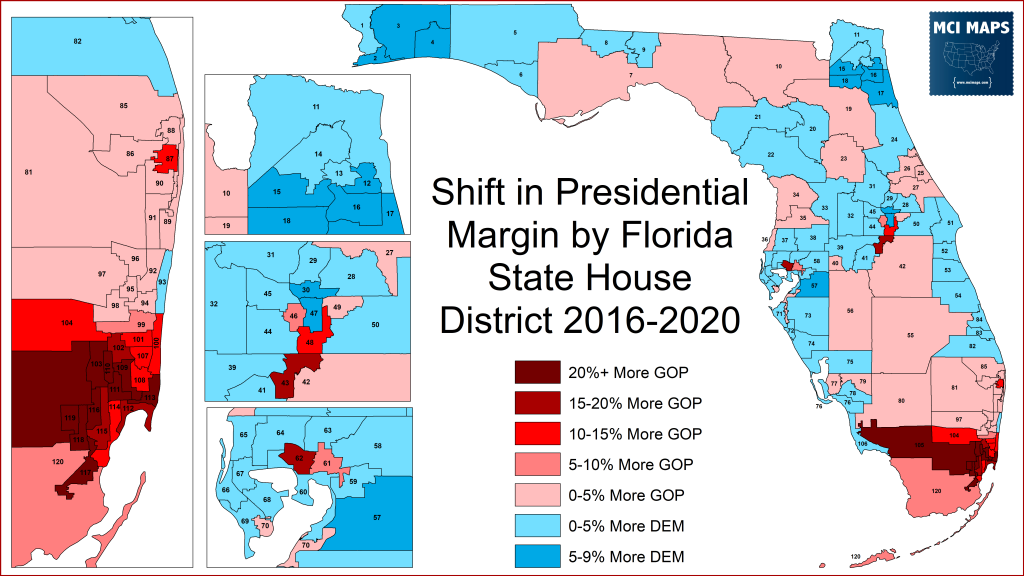With the Presidential election just a week away, Florida finds itself in an unfamiliar position. For the last thirty years, Florida has been a main theater for Presidential elections; considered one of the key swing states. This year, Florida has taken a backseat to the campaigns in classics like Pennsylvania and Wisconsin, but also newer swing states like Arizona and Georgia.
The stage for this development was set when Florida went for Donald Trump in the 2020 election. That moment had a major effect on future national Democratic focus in the state; leaving Florida Democrats largely high and dry for the last four years. The 2020 election was a culmination of several heartbreaking losses for Florida Democrats, really more of the “final nail in the coffin” regarding Florida being considered a pure swing state. Not that Florida is Tennessee or Indiana, but it certainly leans right.
I cannot possibly fit a comprehensive history of the last decade into one article. However, what I want to do here is talk about what happened in 2020 and how it drove Florida off the swing state board. To start, I will do a “short” look back at events leading into the 2020 election. Those moments will help explain why 2020 was considered the “last straw” by many national left-leaning organizations.
With no time to spare, lets dive in.
Background heading to 2020
As I stated in my intro, Florida’s 2020 Trump win did not occur in a vacuum, it was rather the final piece of an increasingly red puzzle. I want to offer a basic timeline of events leading into 2020 to set the political stage. I am glossing over countless events as I do this. Honestly, I could write 100,000 words or more on the events from 2012 to 2020 without breaking a sweat. I’m gonna try and sum it up in just a couple thousand.
The Last Democratic Wins
Before we even got to the 2020 election, Florida was already considered a right-leaning state. Florida had backed Obama twice, but in both instances his statewide wins were weaker than his national margins. In 2008, Obama won Florida by 2.8% while winning the nation by 7.2%. Therefore, Florida in 2008 voted 4.4% to the right of the nation.
While Obama had won Florida, Republicans still controlled much of the state. The legislature, boosted by a 2002 gerrymandered map, was solidly in Republican hands. In the 2006 midterms, despite it being a blue year nationwide, Charlie Crist had won the Governorship to hold it for the GOP. However, when Crist decided to run for the US Senate seat in 2010, Democrats saw an opening. They recruited the Democratic Chief Financial Officer, Alex Sink, to run or the post. However, Sink narrowly lost to businessman Rick Scott in the Governor election. This was considered a fluke win, fueled by the terrible 2010 midterm for Democrats nationally. Scott had won while self-funding and was personally unpopular, but had likely taken the race thanks to the red nature of the year.
In the 2012 elections, Barack Obama and Democratic Senator Bill Nelson would be on the ballot at the same time. Obama would poll close in Florida through much of the cycle, with it never considered a guarantee he’d win the state. Nelson, meanwhile, had some modestly close polling but would eventually poll solidly away from Congressman Connie Mack IV and defeat him by 13%.
Nelson, who long had strong support with working class and rural white voters, would be the last Democrat to win a US Senate race in Florida to date. Meanwhile, Obama would go on to win Florida by right around 0.9% as he won the country by 3.9%. Obama’s win came as the campaign invested tens of millions into field programs in Florida – with GOTV efforts and offices dotting the state.
The Obama win in Florida was 3% points to the right of the nation.
The 2012 results were the last high points for Florida Democrats. The next heartbreak would come in 2014, as Rick Scott won re-election. Scott was considered very vulnerable, not especially popular and going against former Republican Governor Charlie Crist, who’d officially switched parties. Crist had been a moderate Republican Governor and was essentially driven from the party by the Tea Party movement. Now running against Scott, he often polled ahead of the governor. However, amid the 2014 red midterm, which saw Democratic candidates falter nationwide, Crist narrowly lost to Scott.
This loss did not come without any blame for Charlie Crist. Shortly after the vote, I wrote about legit critique’s of the Crist campaign while also discussing what was out of their hands. You can read that here. However, Scott’s narrow win came as he put $20,000,000 in self-funding in the closing weeks; allowing him to blanket the state. The race also occurred in a much redder year than expected; which saw Democrats lose 9 US Senate seats and fail to take several Governorships. While Crist had blame to accept, Scott also benefitted, again, from a red midterm.
The 2016 Loss
Even with the 2014 development, Democrats were hopeful that come 2016, they could keep the state in the Democratic column for President. A major effort took place in 2016 to win the state. Not only was the Hillary Clinton campaign heavily involved, so were several national organizations. Trump’s rock-bottom support with Hispanic voters was going to be a major boost for Clinton in the state. A diverse state like Florida seemed like the exact type of area to reject Trump’s rhetoric. The confidence of winning Florida was there, and… well we all know how that confidence worked out in several states. In the end, Clinton lost Florida by 1.2% of the vote.
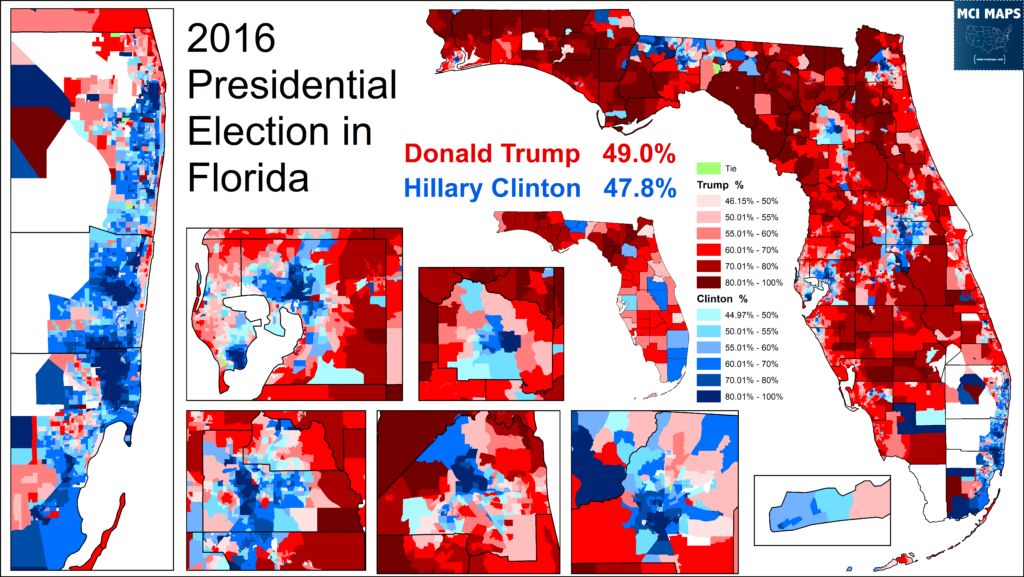
Clinton lost Florida largely thanks to a massive collapse in support among White Working Class voters. This came a common story across the post-2016 analysis, the demographic that propelled Trump the rust belt. Among the working class communities, both rural and urban, Trump made major gains. Meanwhile, Clinton maid big gains with suburbanites, Hispanics, and military voters. Black turnout fell, causing a bigger problem for Clinton than the small swing Trump made with Black voters.
The biggest story of hope for Democrats in Florida was Miami-Dade County. Clinton went on to win the county by 30 points. She made massive gains with Hispanic voters. Depending on your precinct analysis or exit polls, she either won Cuban voters or only narrowly trailed them. Either way it was a MASSIVE swing from previous years. Hialeah, the epicenter of Cuban political life, which had backed Romney by 9% in 2012, only backed Trump by 100 votes.
In January of 2017, I wrote an article looking at the 2016 results by State House district. The map below shows where Trump did worse of better than Romney.
The map confirms what the precinct data showed. Clinton made massive gains with Hispanic voters and suburban voters across the state. However, she lost big ground with rural and working class districts. Areas like Pasco and Hernando, once more light-red with a democratic base, flung hard to the right. The district with the biggest swing to the right was Pasco County’s coast-hugging HD36. This working class seat, home to New Port Richey, went from being narrowly for Obama to going for Trump by 20 points. In this swing, the incumbent Democrat, Amanda Murphy, narrowly lost to 21 year-old UFC student Amber Mariano, the daughter of a county commissioner.
This race, more than anything, summed up the working class swing against Democrats.
The same day Donald Trump won Florida, Republican Senator Marco Rubio secured a 7% win over congressman Patrick Murphy. This has been a major contest for both parties, but as the 2016 election went on, Murphy lost national funding from Democrats, and was left on his own to lose to Rubio. When Rubio won, he held stronger positions with suburban and Hispanic voters – showing they were not firmly in the Democratic camp yet. Below shows where Rubio or Trump performed better.
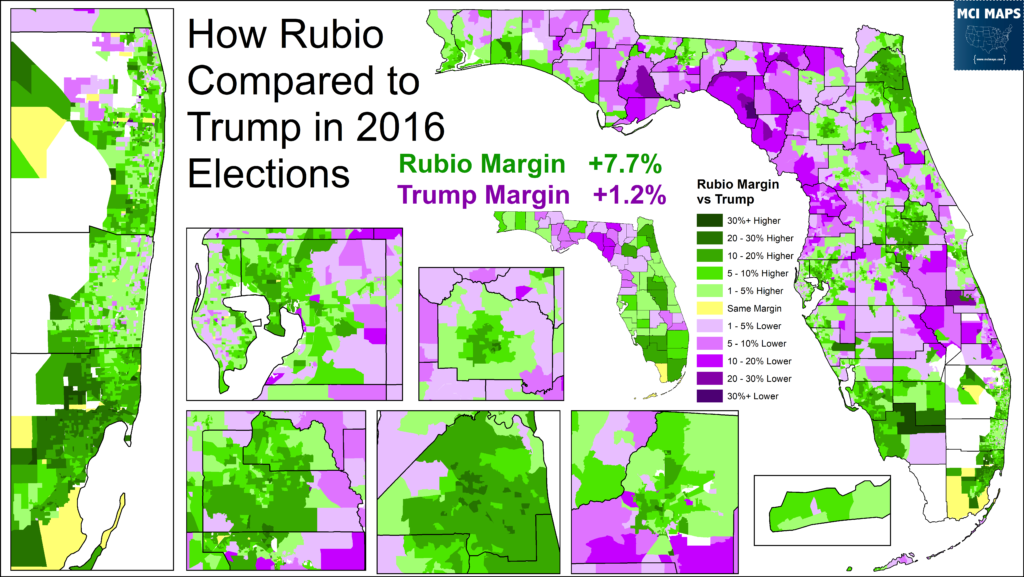
Like many states, Florida would undergo a suburban realignment, as many formerly strong Romney/McCain communities, including those that stuck with Rubio, would move in a more Democratic direction all the way down ballot. It would just take a bit more time.
Florida’s 2016 vote was 3.3% to the right of the national vote. It did not see the collapse in support than places like Iowa or Ohio had seen. How Florida’s vote (red line) compared to national votes can be seen below.
What you should notice, btw, is that Georgia and Arizona swung to the left. While they had not backed Clinton, they were moving in that direction. Florida, at best, was stagnet.
With the 2016 losses, Democrats moved into the midterms.
The 2018 False Hope
The Clinton loss put Florida Democrats, as well as the whole national party, on the back-foot. However, Florida democrats still had reason for hope in the 2018 midterms. Several elections in the ensuing two years had gone their way. I wrote about most here, you can read below..
- Democrats flipped Senate District 40, a Hispanic-majority seat in Miami-Dade, in a special election. (Article here)
- St Pete Democrats held the Mayoral office after Rick Kriseman won re-election against the former Republican Mayor, Rick Baker. This Kriseman win was considered a major upset. (Article here)
- Democrats flipped a Trump-voting Sarasota-based house seat, defeating the son of Congressman Vern Buchanan. (Article here)
- Democrats held onto a swingish Miami-Dade State House district after the incumbent was forced to resign. (Article here)
- Democrats did better than expected in the special for an Orlando suburban house seat that saw the initial DEM candidate forced out of the race. Democrats would formally flip this seat in the 2018 midterm. (Article here)
- Democrats took control of the Miami-Dade county commission after a special election saw a Democrat flip the district against strong Republican names. (Article here)
So heading into the 2018 midterms, which would overall be a good night for national democrats, Florida Democrats had hope for taking the Governor’s mansion and holding Bill Nelson’s Senate seat. However, the midterms would hardly go as Democrats hoped.
In the 2018 midterms, while Florida Democrats made some legislative and congressional gains, Democratic nominee Andrew Gillum lost to Congressman Ron DeSantis for governor. Ron DeSantis had secured the GOP nomination after he got the backing of Donald Trump. I documented that whole saga here. Despite leading most polls, Gillum, the Tallahassee Mayor, lost by just 40,000 votes – even closer than the 2010 or 2014 Governor races.
Gillum’s upset Democratic primary win over former Congresswoman Gwen Graham was arguably when the Democratic lost the race. Gillum was an ethically-compromised mayor that, beyond the flash of his campaign, has serious strategy issues. I covered Gillum’s entire saga in a special newsletter you can read here. Gillum was hit for an ongoing ethics scandal, and his onetime confident, corrupt developer Adam Corey, turned on him in the closing weeks. Gillum’s 40,000 vote loss can easily be attributed to his ethical baggage. Gillum also ended the campaign with several MILLION dollars in campaign accounts – as the candidate sought to set himself up for a 2020 Presidential campaign after his win. Instead he lost and then had a major fall from grace – which I covered in the link above.
But while Gillum’s loss could be seen as a self-inflicted wound, the status of Florida as a lean GOP state was cemented by Governor Rick Scott defeating Bill Nelson for the US Senate seat. I had dubbed this race the “Clash of the Titans” in a preview in the summer of 2018.
The race was decided by just 10,000 votes – a heartbreaking loss for Florida Democrats. He might have actually only lost the race by 1,000 or so votes – but for more info on that read my story about the monumental screw up on the Broward County ballot. Regardless, this was a Rick Scott victory that could not be pinned on a red national environment.
Nelson’s loss had come from not holding the same margins he’d once commanded with working class white and rural voters. Part of this was changing populations, with folks who backed Nelson in the 1990s and early 2000s largely gone. Another issue was increased polarization – with voters unwilling to ticket split as much – concerned about control of the Senate/House and less driven by personal loyalties. Nelson also lost ground with Hispanic voters, as did Andrew Gillum. I covered this in great detail in my “What went Wrong in Miami-Dade” article from early 2019.
There was one bright spot for Florida Democrats statewide. In the overlooked race for Agriculture Commissioner, lobbyist Nikki Fried defeated State Rep Matt Caldwell by just 6,000 votes.
This win, and the relatively close losses, gave Florida Democrats “some” hope. However, by this point it was becoming increasingly clear that Florida was moving in a direction where Florida Democrats were underdogs.
The State of the State for 2020
Heading into the 2020 general election between Donald Trump and Joe Biden, Florida remained “on the board” as a swing state. The Biden campaign was making efforts in the state, though it was clear that the Democratic focus to securing the White House lied in the rust belt. I even predicted Georgia would likely vote to the left of Florida that year, and that a Florida win likely only would occur if a big blue sweep of other states was happening.
Why did I think this?
Notable Data Points
By the time of the 2020 election, it was clear that the electorate of the state tilted toward the Republican Party. There were several major data points that drew me to this conclusion. In the lead up to the 2020 election, I wrote a guest piece for the Center for Politics, laying out the struggles for Florida Democrats.
- Increasing migration from midwestern conservative retirees were outpacing the liberal Jewish retirees that once flocked to South Florida.
- Increasingly conservative movement of Hispanic voters, especially as the major problems in Venezuela created a new “left wing bogyman” to replace the outdated Castro talk.
- Longtime Republican control of the state leading to a very powerful and better funded Republican operation.
- No sign of turnaround with working class white voters – a key Obama demographic in his 2008 and 2012 wins.
- Suburban swings being stifled by a large wealthy population that stubbornly remain Republican due to tax issues.
- A Democratic Party base that was far less reliable to show up, meaning left-wing groups had to focus much more on GOTV than Republicans, further limiting persuasion focuses.
Florida’s politics were changing. This was clear in an article I wrote heading into the 2020 election. The I-4 corridor, a string of counties in Central Florida, has once been the fortune teller for Florida. How it went, the state likely went. In both 2000 and 2004, the I-4 and State margins had been near identical. By 2016 and 2018, the I-4, was voting increasingly to the left of the state.
Another article I wrote that fall looked at the issue of Florida’s disapearing swing counties. Back in the 1990s, around 19 of the 67 counties had been within 5%. By the 2020 era, only a couple counties remained divided. Most counties became deep blue or deep red.
The COVID Pandemic
The COVID-19 pandemic severely impacted the state of campaigns in Florida. First, it created the infamous polarization of voting methods in the state. As Donald Trump railed against voting by mail, lying that it was subject to fraud, it led to Republicans abandoning a method they had once been the major leaders of. Democrats, meanwhile, embraced Vote by Mail as the safe option amid a deadly pandemic that would kill over one million people worldwide by the time of the election. As a result, mail voting in Florida would be extremely Democratic while in-person voting would be heavily Republican.
The COVID dynamic also affected campaigns. The Biden campaign did not do nearly as much door knocking as previous Democratic campaigns. The extent of GOTV would vary wildly by state. Within Florida, local campaigns and organizations took up more in-person GOTV efforts, aiming to keep it safe with masks and distancing. However, compared to the aggressive field programs seen in Florida in 2016 by Democrats, far less occurred four years later. Meanwhile, Republicans did keep up a ground came.
Registration Warning Signs
Heading into the election, Democrats maintain a small lead in voter registration. Democrats had long held a registration lead in Florida, but it was shrinking with every year for over two decades. In 2022, I would do a detailed cover of these registration trends, which you can read here. By the end of registration in 2020, the Democrat lead was 0.9%. In the 2016 election it had been 2.5%. The shift by county can be seen below.
Democrats were largely losing ground in all counties outside of major urban centers. They continued to bleed ground with rural white voters, especially in the ancestral Democratic panhandle around Tallahassee. However, Republicans had also made solid NET gains in Miami-Dade, the Southwest retiree and suburb counties, and working class counties like Pasco, Brevard, and Volusia. These were all bad trends for Democrats.
However, the one issue to lock in for me that Trump would win Florida was the registration shift from just August to November that year. In two months the Republicans would make a net gain of 106,000 voters.
The period between the August Primaries and November General in a presidential year is always a time a major registration jumps. However, it has historically been a time Democrats would NET gain voters, thanks to strong field programs. The fact that Democrats badly lagged in new registration told me that the ground game efforts were indeed very lacking. If this was the case with registration, it was hard to see turnout going better.
This is when I was telling the Center for Politics and others that I expected a Trump win Florida.
The 2020 Election
In November, the election finally came to Florida. Of course, voting had already been going on for a great deal of time.
Pre-Election Day Voting in Florida
Donald Trump’s attacks on vote my mail had a major effect in Florida. Democrats quickly became the party of voting by mail as Republicans insisted voting in person was the only way. In Florida, this resulted in absentee ballot requests and returns being heavily Democratic. This was first seen in the August primaries, where Vote by Mail went from GOP +4 to Democrat +16 over a two year period.
The only sources of GOP improvement in vote by mail was several of Florida’s rural Dixiecrat counties – this largely driven by voter registration changes. The lone other county was Sumter, home of the Villages retirement community. If you know anything about the Villages, you know it as the GOP retiree mecca.
Meanwhile, the primaries showed a massive shift in in-person early voting. The 2018 primary had been DEM +3, but in 2020 it was GOP +14.
The primary shifts would be very predictive for November. When all ballots were cast for the general, the Vote by Mail method was DEM +14 while Early Voting was GOP +12. Democrats would build up a MASSIVE lead in votes cast through the month of October. Early voting then began and was steadily Republican.
The lone Democratic day of early voting was the last Sunday before the election. If you know anything about campaigns in Florida, you will know this is commonly “Souls to the Polls” day – a time when voters from the Black churches will flock to the polling centers after Sunday services. Not only has this become a tradition in many Black communities, it is often an organized rally and event in major communities. Early voting was not occurring in every county that Sunday, but it was in all the major metros – all with large Black populations.
The polarization of VBM and in-person early voting resulted in Democrats slowly building up a massive vote-cast lead through much of October – only to see it eaten away as early voting began. Below is showing the DEM advantage over the GOP through the entire month.
With over 6,000,000 cast before election day, Democrats had a lead in votes cast of 6%. All that would be left was election day itself.
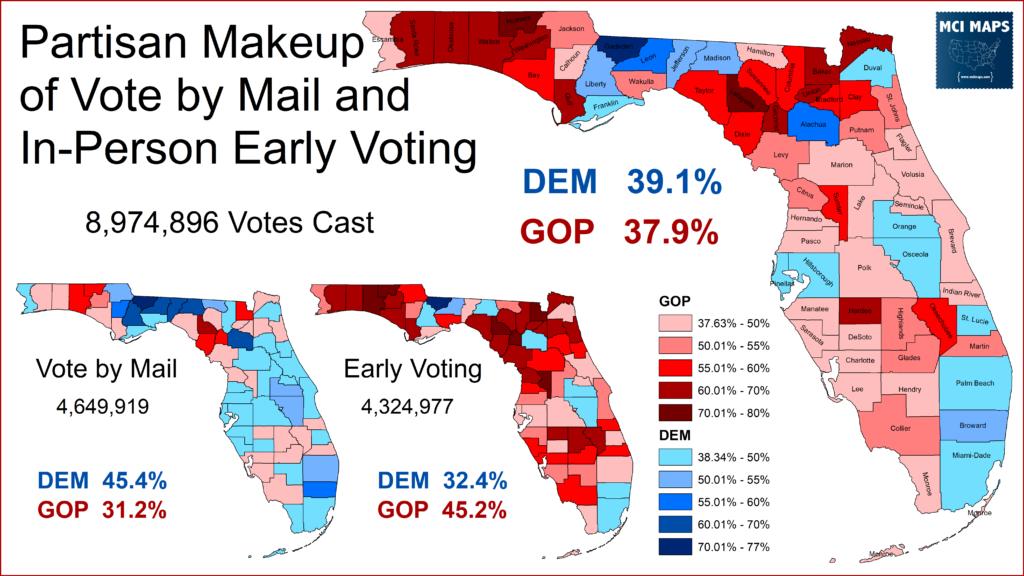
While Democrats maintained 115,000 voter lead heading into election day, this was not a strong place to be in; as election day was expected to be heavily Republican. Anyone who followed me at the time knows I was sounding several alarms about some of the early voting turnout data.
Early Voting Warning Signs
As early voting had gone on in Florida, I was increasingly concerned about turnout in a handful of key urban areas. There was no area I was more worried about than Miami-Dade. In the days heading into election day, the turnout between the two parties was nearly even. However, at a county level, there were wild variations.
Democrats lagged badly in several rural counties. However, this was fairly normal, as the old white conservative democrats often voted Republican anyway. However, the 7%+ turnout gap in Miami-Dade was a major concern.
This gap was driven most by a sizeable difference in turnout among Hispanic voters. Statewide the Republicans already had a lead in Hispanic turnout, leading by almost 10 points already. This was driven heavily by the partisan gap in Miami-Dade, the biggest source of Hispanic voters.
During early and mail voting in Miami-Dade County, Democrats maintained a turnout lead among white and Black voters. However, the Hispanic gap in turnout was leading to major problems. It foretold more Hispanic Republican excitement for Trump and a more passive mood among liberal-leaning Hispanics.
What made things worse was that election day did not promise anything food for Democrats. Looking at who had yet to vote, there were far more “super voter” Republicans left than there were Democrats. For example, among voters yet to cast ballots but had voted in 4 of the last 4 elections, the GOP had a 200,000 person lead.
Everything said a red wave on election day was coming.
The Election Day Red Wave
On Election Day in Florida, there was indeed a red wave. The election day vote, the smallest voting method of the three, the Republicans lead Democrats by 19 points.
Final turnout would be 76%, with the GOP maintaining a 6% turnout lead.

Looking at turnout by Party AND race, you can see that Democrats largely held their won with White, Black, and Asian/Other racial groups. However, among Hispanic voters, the GOP ended with a 10 point turnout lead.
The racial makeup of the 2020 vote by precinct is below.
Turnout by precinct can be seen below.
The weakest turnout precincts in Florida largely covered around Black or Democratic Hispanic communities. This was not the type of turnout disparity, with it voter turnout falling below 60% in several Black communities, that would allow Democrats to win.
The 2020 Election Results
By the day of the election, I was expecting Donald Trump to win Florida, and said as much privately to different people. My belief was Trump would lose nationwide, but Florida would be an early bright spot for him. This came to pass when the early/absentee data came in. Biden had a lead, but the election day vote was sure to push Trump ahead. Several counties had warning signs, but the numbers of out of Miami-Dade said all that needed to be said.
I called Florida before 7:30. In the end Trump would take the state by 3.3% of the vote.
I’ll go over these details further down in this post, but a few key things aided Trump in securing his victory in Florida.
- A major swing toward the GOP with Hispanic voters
- While Biden stopped much of the white working class bleeding for Democrats, he did not rebound much from the 2016 collapse, and in some areas did the same or slightly worse than Clinton
- A small swing with Black voters to Trump, however the bigger issue here was turnout
- Educated White suburbs and retirees, both groups Democrats hoped to make big gains with, were more modest overall – not as big as in other states.
The precinct map above shows a great deal of red, but much of that is rural areas. A better way to visualize the results is this map showing the density of Biden v Trump votes per square mile. Darker red/blue precincts show not the % margin, but rather how many NET votes each candidate relative to the size of the precinct.
As the density map shows, much of the solid Trump areas, in terms of %, were low populated. However, Republicans have a strong corridor of support up and down the coasts of Florida – areas that are a combination of upper-income, anti-tax Republicans and GOP-leaning retirees. You can see the Villages retiree community in Sumter county with this density model.
In terms of Presidential results by voting method, several counties did not provide the breakdown. However, counties representing a vast majority of the vote cast did, and the results show a clear correlation with method. Trump won early vote and absolutely dominated on election day.
Democrats built up a massive margin with vote by mail, but that was erased in-person.
How Biden and Clinton Differed
So how did Biden’s 3% loss compare with the 1% loss that Hillary Clinton suffered four years before? Well, despite doing worse statewide, Biden flipped 3 counties. He took Duval and Seminole, both testaments to Democratic gains in the suburbs, as well as the perpetually-swingish Pinellas County. However, he lost ground in much of the I-4, rural counties, and especially in Miami-Dade County.
A precinct version of this swing can be viewed below. The biggest Republican swings, by far, were in heavily Hispanic communities. In Miami-Dade this really added up, but you can see the different Hispanic populations in Orange, Osceola, Tampa, Hillsborough, and Palm Beach just by looking at the dark red. For Democrats, their gains were more modest overall, with few deep blue precincts.
Don’t worry I have more precinct data and maps further down in this article. Will be looking at some key counties to highlight the points made.
Another way to view swing is not just percent change, but also raw vote change. In 2016, Clinton lost Florida by 112,000 votes. Biden lost it by around 380,00. The map below shows the raw vote swing by county from 2016, with blue counties showing Biden having a better raw vote margin than Clinton, and red being vice-versa. On the left side of the map is the percentage swing we already covered. Notice how percent swing did not always correlate with raw vote swing.
Several counties, places like Sumter, Sarasota, or Collier, saw Biden lose these counties by a smaller % than Clinton did. However, due to increased turnout and population growth, a smaller % win for Trump still equaled more additional votes. After all, if an area has 200,000 votes and you win it 65% to 35% – then the next election it has 300,000 votes but you only win it 63% to 37%, you are still going to NET additional votes. Republicans did an excellent job at increasing turnout and allowing swings against them to still yield NET vote gains.
Biden did improve his the vote margins in places like Orange and Hillsborough despite losing ground percentage-wise. This was thanks to major growth in these counties. In addition, several margin growths were strong enough to yield net votes: like in Clay, Brevard, and especially Duval. However, while Duval gave Biden his biggest NET gain from 2016: just around 25,000 votes, Trump’s best county of Miami-Dade netted 206,000!!!!!!!!!! That was nearly the entire margin growth from 2016.
That raw vote swing map can be seen in precinct form below.
There were plenty of solids spots of Democratic growth – largely in the same areas as the 2016 election. However, steady gains across much of the state, and the disaster in Miami-Dade, ate away at all of it and then some.
Partisan Allegiances
Democratic turnout was an issue for Biden in Florida. The 6 point gap in votes cast was not ideal, and was compounded by the fact that not all Florida Democrats are steadily left-of-center. I’ve discussed this multiple times before, and you can read a 2023 article of mine here, but the rural Democrats of Florida, especially in the panhandle, are conservatives. For a long time, many counties would only ever elect Democrats to local offices but vote Republican at the top of the ticket. Think your classic deep south voters or Appalachian Coal Democrat. In 2020, Biden drastically underperformed Democratic share of the vote in several rural areas. In the map below, Blue is where Biden’s % was higher than the registered DEM % of the vote cast, and red is him doing worse.
Biden largely kept Democrats outside of the panhandle, and some rural farm communities, steadily on his side. This panhandle protest is a longstanding issue – seen with the Obama and Clinton campaigns, as well as countless federal Democrats before.
Republicans do not have this issue as much. Their issues with suburban Republicans is there, but pales in comparison to the rural Democratic issue. Below this map shows whether Trump or Biden outperformed their party share the most. To easily explain it, Blue = Biden held his party together more than Trump. Red = Trump holding his party more together than Biden.
The map shows how Biden held his party together better in the suburbs, where Trump likely lost ground with these Republicans and independents bucked the GOP. However, the rural communities were much more united around Trump. Meanwhile, you can see that solid red corridor in Miami-Dade. Biden lost votes from some Hispanic Democrats, as well as a large number of Hispanic independents.
With that Miami-Dade note, I think its the perfect time to dig more into some detailed demographic dives.
Demographic Analysis
This section will discuss some of the notable demographic swings in the state. I cannot possibly do justice to every grouping. However, I want to cover the main highlights of how different groups of people voted and shifted from 2016. Lets start with the biggest story – the Hispanic swing.
Hispanic Voter Swings
We are going to talk about Hispanic voters first. However, it is important to note that Florida Hispanics are hardly a united block. The American Community Survey Data below shows the different nationalities that make up the Hispanic community of Florida. Note this is not registration data and rather it is census estimates.
Cuban voters solidly dominate in the Miami-Dade region – with South Americans steadily rising in the area: especially Venezuelan residents. Southeast Florida has large Columbian and Argentinian populations as well.
Puerto Rican voters are the biggest Hispanic group in the Orlando area, something I went into in more detail for my “I-4 Corridor” article. Tampa also is home to a historic Cuban community. Meanwhile many of the farmlands have large Mexican populations – including migrants and citizens. These areas, in terms of registration, remain heavily white. In an article I wrote on Hendry County, you can see how the area is majority-Hispanic in the census but majority-white in voter registration. That said, the Hispanic citizenship and registration rates are slowly growing in these rural communities.
The issues with Hispanic democratic turnout were part of the reason for sizeable swings in 2020. However, this was not the only reason. Republicans were able to make major inroad with Hispanics over several issues….
- Increasing use of right-wing Hispanic radio to push narratives about current events
- Rebellions to the COVID lockdowns, something that became associated with overly-involved government.
- Tensions with the Black Lives Matter movement, with divides among different communities over policing and the issues around police funding. Many Hispanics, especially Cuban voters in Miami-Dade, were very much against “defund the police” discussions. This became a major issue in arenas like the Weston Mayoral Race.
- Weaponization of more conservative social issues, something more played out with Cuban or Mexican Catholic voters
- Increasing problems in Venezuela with the “left-wing” dictator Maduro becoming a new left-wing boogeyman as Cuban fell from the main talking point in Miami-Dade. I actually did a major write-up on Venezuela just a few months ago.
- Lack of democratic ground game making it hard to counter right-wing attacks. Many Democratic ground game efforts that did occur in Miami-Dade did not penetrate deep into Cuban-heavy areas.
These and a host of other issues led to a massive swing in Miami-Dade county. After Clinton won the county by 30, Biden won it by just 7%.
The swing map by precinct was the first map I made after the election was over.
The collapse in Dade was monumental. In 2016, Hillary Clinton had won all the State House districts in Miami-Dade. In 2020, Trump had taken back a vast majority.
I delved into some more Dade details in my 2020 results by State House article. One seat that perfectly reflects the collapse was House District 103. This seat, who’s south end covers Cuban-heavy communities around Hialeah, saw a 28 point swing.
With that swing, Cindy Polo, the first Democrat to win the district in 2018, lost re-election. Polo had initially not been considered remotely vulnerable. But no one expected the Biden collapse that occurred.
To get a better feel for the swing with Hispanic voters, I broke things down to the precinct level. I stuck with precincts over 70% Hispanic, basically trying to weed-out any other demographic factors. This left me with precincts entirely in Miami-Dade or Osceola. Here we see the difference in Hispanic support from 2016 and 2020; with the Puerto Rican heavy Hispanics being solidly Democratic and remaining such, while Miami Hispanics went from DEM +10 to GOP +20. Either way though, the swing was close to the same, 25 to 30%.
This is a very important data point. While the Hispanic voters of Miami-Dade got the most attention, we saw these swings across the state and nation.
Speaking of Osceola County, it was overshadowed by Miami-Dade. However, it saw a sizeable swing to the right, albeit remaining firmly Democratic. The swing to the right perfectly correlates with the Hispanic corridor of the county.
Over in Hillsborough, the Hispanic community, which is plurality Cuban, saw similar solid swings. The Black community, which I will discuss more further down, saw more modest drops. However, thanks to Biden gains in the suburbs, the county result was essentially the same.
Back over in Orange County, there was a similar near-identical margin. Like Hillsborough, Biden lost big with Hispanics, lost small with Black voters, but made massive gains with white suburbs.
Down in Palm Beach, the story was the same, with the Hispanic community being the biggest source of vote drops.
Palm Beach is also important for discussing older retirees. We will circle back on that as well.
In Hialeah, the embodiment of Cuban political strength, the swing was absolutely stunning. After Hillary Clinton almost made history in losing the GOP city by just 100 votes, Joe Biden went on to lose the city by 28,000 votes.

In this data though, notice the raw vote. Biden lost Clinton voters, no doubt, as he got 7000 fewer. However, the source of Trump’s margin here was getting 20,000 more votes than last time. Turnout was up 12,000 in the city.
We see a similar story in Doral, Florida – the home to a large Venezuelan population and the site of decent population growth. Clinton won the county by 40% and Biden lost it by 2%. Like in Hialeah, increased votes was a major factor.

Biden got nearly the same number of votes as Clinton, but with a big vote increase, it meant losing the city rather than winning it in a landslide. The same story again occurred in Weston, a city in Broward County. Weston is now a majority-Hispanic city; one of the many Hispanic-heavy suburbs of Southwest Broward that have seen increasing racial diversity over the last 20 years. Here we see a more modest Democratic drop, but its still a 12% swing – again driven by new votes going largely one way.

It should be noted, because they became a major debating point after the election, that these tables do NOT mean that Biden got all of Clinton’s voters and it was simply new people showing up. Biden getting basically the same vote total as Clinton did in Doral likely means he lost a few thousand of her voters but gained some from the new residents. Increased turnout, and population growth, meant Biden for sure gained SOME of those voters; so he had to have lost Clinton voters to maintain parity.
A full look at the swings by all Florida precincts shows that as an area became ore Hispanic, it swung more to the right.
The Biden collapse with Hispanic voters was the biggest story out of Florida in 2020. However, several other demographic items should not be overlooked.
Black Voter Swings
Overall in 2020, Biden lost a small bit of ground with Black voters. How much he did varied by county; but overall it was under 5%. Below is the swing in precincts over 80%+ Black.
In Miami-Dade, the swing was much higher at 9%. Part of this is the impact of Hispanic voters in the precincts (even those heavily Black) and the fact that some Black voters in the area may also be Hispanic-Black. This is a less common dynamic outside of Southeast Florida.
Over in Duval County (Jacksonville) – Biden flipped this county, which had not voted Democratic for President in the 21st century. His win came thanks to strong growth in the suburbs, but he lost small ground with Black voters in the Northside of the city. Granted these swings are far more muted than it was with Hispanic voters.
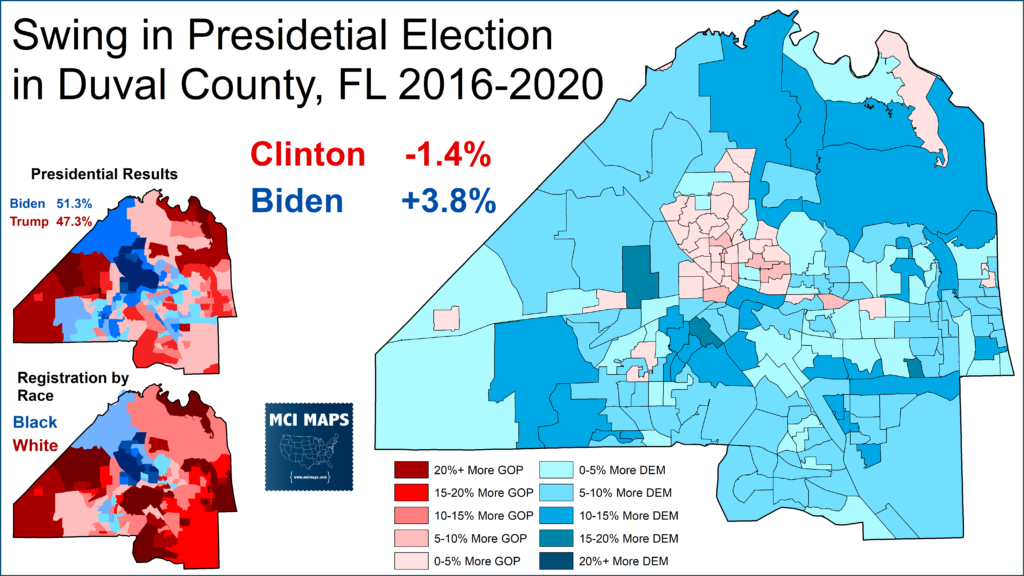
Over in St. Petersburg, located in Pinellas County, Biden increased his share of the vote in this solidly Democratic city. However, the areas where Biden lost ground the most were the Black community.
Down in Broward County, the central and south portions of the county are heavily Black. Both were sites of Biden drops in support – which cost him precious votes in this MASSIVE Democratic bastion. His drops were also worse in the south end of the county because that is also the site of large Hispanic populations.
Biden’s drop in Black support in Broward appears to be fairly static – regardless of the community being traditionally African-American or part of the growing Caribbean population. The South Florida region especially has a sizeable Caribbean voter block.
I have discussed before, namely in this article on Miami-Dade County, about how Caribbean and non-Caribbean Black voters can diverge on issues. However, this divergence is often more with primary elections. Indeed in the 2020 general, there does not appear to be a massive distinction between Caribbean vs African-American voters in terms of voter swing.
Granted this is a tricky thing to verify with precinct or house data, as many of the Carribean-heavy communities also have large Hispanic populations. To see what I mean, below are the House seats that were majority-Black in 2020 and how they shifted their voting over the years. Two Miami-Dade seats, 108 and 107, saw larger swings against Biden. However, these districts also have a solid minority of Hispanic or Hispanic-Black voters. Meanwhile, House district 95, a Caribbean-heavy Broward seat with few Hispanic voters, had a much smaller swing.
Broadly I think its correct to say that the difference between Caribbean and African-American only really shows up in terms of swing if Hispanic nationality is part of the profile. This is a demographic divide that is best answered in more detail with survey research.
Older Voters and Jewish Retirees
Heading into the election, it was widely believed Biden could make inroads with senior voters. Biden’s age, and the attacks he suffered for it in 2020, was thought to have a potential backlash effect. In addition, senior concerns over the COVID pandemic, and the Democrats taking a more pro-mitigation posture over the issue, would further aid in making some gains.
The precinct data does point to a senior voter swing to Biden, albeit modestly. In Sumter, Marion, and Lake, all which have parts of the Villages retirement community, Biden’s margin improved by 5 points over Clinton. These voters are solid conservatives. Meanwhile, things remained static with the more left-leaning Palm Beach retirees.
The Villages, the massive retiree communities that is largely in Sumter County, has been a major political story in Florida for year. The continuously growing development now makes up over 70% of the voting population of Sumter, which otherwise is rural county. In 2020, Sumter swung to the left thanks to the Villages moving in a Democratic direction. However, the community remains firmly Republican, still a destination for conservative retirees.
Biden by and large made gains with senior voters. When I expand my search to those over 70% retiree age, you see most counties have a blue swing. Palm Beach and Broward, however, move toward Trump.
A big question that emerged here was if Trump’s efforts to win over Jewish voters was successful. In Orthodox communities in areas like New York, there was a massive shift toward Trump. For example, in the New York City based House District 50, the Hasidic Jewish population in the southeast end saw a major swing toward Trump.
However, much of Florida’s Jewish population is not so concentrated in areas to gleam if a swing was due to some other factor. As I note in the table above, the Broward swings were precincts less white. Among the older precincts in Palm Beach that were the whitest, the swing was 1% more toward Biden.
Data out of Miami-Dade showed a stronger swing of Jewish voters against Biden. There is a larger Orthodox Jewish community there, as well as a large Hispanic Jewish population. There is a growing Argentinian Jewish population in the county. In fact, the same day as the Presidential contest, Daniella Levine Cava won the Dade Mayoral race for Democrats. Her map, and how did vs Biden is below.
Cava was strong with Jewish voters. Do you see that dark green cluster in the upper-right corner of the county? That is home to many Hispanic and Orthodox Jewish residents. Cava managed to hold many precincts there that otherwise went for Trump or became nearly tied after previously being solidly blue.
Its entirely likely Trump did make gains with Orthodox Jewish voters, but non-Orthodox voters, who in south Florida lean not only democratic but socially liberal (often voters that rejected the 2008 same-sex marriage ban in Florida) stuck with Biden. For example, Wynmoor in Broward County is a large Jewish retiree center. It voted against the same-sex marriage ban in 2008. It saw only a small swing against Biden. About 20% of its vote is non-white.
I actually wrote all about Wynmoor and the power of the retiree condo communities in local politics in an article here.
How Biden did with Jewish voters depended on several other factors, like nationality and religious order. Here is another topic where detailed survey research can tell us more than precinct analysis.
Working Class Whites vs Suburbs
Democrats in Florida were banking on Biden making gains with suburban voters and clawing back some of the working class voters that Clinton had lost big with in 2016. Among the educated suburbs, Biden did make gains. However, they were not as large as had been hoped.
In Seminole County, a once solid Republican exurb of Orlando, Biden did FLIP the county to the blue column. The swing was 4.4%, not as much as Democrats hoped. However, it was a historic flip.
Over in Clay County, an exurb of Jacksonville that remains DEEP red, Biden did 6 points better than Clinton did in 2016. Biden actually managed to win a handful of precincts, which is itself noteworthy. The North end of the county, which borders Jacksonville, swung solidly to the left as its rural outskirts moved further right.
By and large Biden did make consistent gains in the educated suburbs. Below is the top 10 most educated State House districts in Florida that year. They descend in order, with HD44 being 45% Bachelors degree or Higher and HD 29 being 35% Bachelors degree or higher.
Only two districts did not swing toward Biden vs Clinton. HD89 is a very wealthy coastal-hugging district in Palm Beach county. It is home to many anti-tax fiscal conservatives. Meanwhile, Broward County’s HD104 saw a 10 point swing against Biden.
The culprit here? HD104 has a large Hispanic population. Weston, which we covered already in this article, lies in this district. The Hispanic swing against Biden overrode the gains with educated suburbanities.
Biden did make tangible gains with suburban voters. The effect of these gains can actually been seen in Pasco County – the working class county that saw a massive swing toward Trump in 2016. Pasco moved slightly to the left in 2020. However, much of that gain was due to increased support in the southeast end of the county. To visualize this, here is Pasco County, which in 2020 was perfectly divided into three state house seats.
In 2020, Biden improved over Hillary Clinton in two of the districts, those covering the east end of the county. These two districts are the most effected by growth of the Tampa suburbs, which are now spilling across the county border and into Pasco. As such, Biden made gains there. However, he did worse in the much more working class HD36 – the site of Clinton’s biggest 2016 collapse.

And as the HD36 red-shift shows, Biden had a mixed record with the working class white voters of Florida. Biden did manage to narrowly take back working-class Pinellas County. However, he only improved by a few points, and most of his gains were in more well-off suburbs.
Biden did not make real improvements in places like Volusia County, or manage to flip back St Lucie County. Overall this was a key problem for him in Florida, not winning back working class voters in any major way. That plus modest but not massive suburban growth meant that there was no way to counter the massive collapse with Hispanic voters.
The 2016 to 2020 swing by State House district I think is very helpful here. Look at how much deep red (big Trump gains) there is. There are no House seats that swung that far to the left.
Biden made his gains with suburban voters, but it was nothing compared to Trump gains with Hispanics. On top of this, working class seats like HD36, HD35, HD26, or HD27, moved further to the right. Rural districts moved a bit to the left or right, balancing themselves out. In all, Biden did not make enough suburban gains to counter issues that still linger with working class and rural voters.
Final Demographic Notes
Long story short, Biden made some improvements over Clinton, but nothing especially big. Not big enough to take the state. Even a more modest Hispanic swing to Trump would have led to a smaller Trump victory, not a Biden win. The massive Hispanic collapse dominated the story out of Florida once the election was over. However, beyond that, the demographic back and forth still showed it was not “one group” that cost Biden Florida. Had Biden not seen his massive Hispanic drop, maybe he loses Florida by another painfully-close margin – something Florida Democrats were used to seeing by this point.
Post 2020 Summary
In the days after the 2020 election, the New York Times ran this headline about Florida.
That line came from yours truly. As you can see further down in the article.
“It’s really hard to argue Florida is a true swing state,” said Matthew C. Isbell, a Democratic data strategist in South Florida. “It’s not Missouri. It’s not Ohio, where Trump won by eight points. It’s just more modestly Republican — kind of like North Carolina, but even a little further to the right.”
Since the 2020 election, this status has been confirmed. While fanboys of Ron DeSantis try and give him credit for the shift, the Florida dynamic began long before he ever sat in the governor’s chair. The 2022 midterms would see Republicans win in landslides. This was driven heavily by an historic turnout collapse, something I covered here.
That series of races, which saw Marco Rubio and Ron DeSantis win by over 15 points, came as little national democratic investment came to the state. In 2018, Andrew Gillum has received tens of millions in outside aid for his bid. In 2022, Democratic nominee Charlie Crist barely got a couple million. Meanwhile Republicans had a machine spending well over $100,000,000 in the races that year. Once Florida fell off the swing state board, it left a broke and demoralized Florida Democratic party on its own against a well oiled Republican machine.
Now as we look at 2024, few expect anything other than a Trump victory in the state. Florida Democrats, now led by Nikkie Fried, are working hard to make gains and slowly rebuild. After 2022, Democrats managed to flip the Jacksonville Mayoral Race, flip a swingish Orlando House seat, and fended off Ron DeSantis in several school board races in August.
The 2024 goals for Democrats is to get as many of their voters out as they can with the resources they have. The Republicans hold a solid registration advantage at this point, guaranteeing the final vote statewide will have more registered Republicans than registered Democrats. However, Democrats are focused on taking a litany of state legislative seats, trying for some long short congressional bids, and flipping some county commissions. Florida Democrats are in a rebuilding period.
Whether Florida re-enters the arena as a swing state down the line remains to be seen. The next few years will be about growth and rebuilding. We will see where things are in 2028.

